-
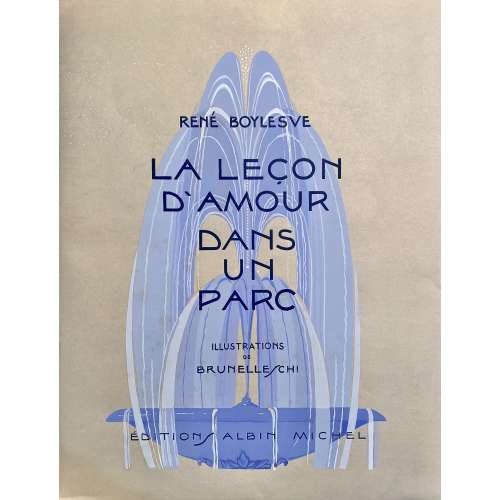 Title page (blue and black): RENE BOYLESVE | LA | LEÇON D'AMOUR | DANS UN PARC | ILLUSTRATIONS EN COULEURS | DE | BRUNELLESCHI | PARIS | ÉDITIONS ALBIN MICHEL | 22, RUE HUYGHENS (14e) || Pagination: [6] 1-173 [174] [4], total 184 pages, ils. Collation: publisher’s pictorial wrappers with 2 blank leaves – front and back, π2 (h.t. / justification, t.p. / blank), 87 leaves of text, [1] colophon / blank, total 92 leaves plus 21 plates, incl. frontispiece. Binding: 33.5 x 26 cm; original flapped wrappers, blue fountain and lettering to front, lettering to spine, back blank, in a marbled buckram folder (33.5 x 27 cm) with lettered paper label to spine; printed on Arches wove paper, margins untrimmed. Illustrations: 42 vignettes, tail- and headpieces in color, frontispiece and 20 plates after watercolours and gouaches by Umberto Brunelleschi printed in black and stencil-coloured (au pochoir) on the 18th of November 1933 at R. Coulouma press (Argenteuil), Jacomet press and Padovani press. Contributors: René Boylesve [Tardiveau] (French, 1867 – 1926) – author. Umberto Brunelleschi (Italian, 1879 – 1949) – artist. Daniel Jacomet (French, b. 1894 – ?) – printer. Imprimerie Coulouma (Argenteuil), Robert Coulouma (French, 1887-1976) – printer. Éditions Albin Michel (Paris) ; Albin Michel (French, 1873 – 1943) – publisher. First edition of René Boylesve's novel La Leçon d’amour dans un parc was conducted in Paris by Éditions de la Revue Blanche, in 1902. Description of the stensil (au pochoir) technique.
Title page (blue and black): RENE BOYLESVE | LA | LEÇON D'AMOUR | DANS UN PARC | ILLUSTRATIONS EN COULEURS | DE | BRUNELLESCHI | PARIS | ÉDITIONS ALBIN MICHEL | 22, RUE HUYGHENS (14e) || Pagination: [6] 1-173 [174] [4], total 184 pages, ils. Collation: publisher’s pictorial wrappers with 2 blank leaves – front and back, π2 (h.t. / justification, t.p. / blank), 87 leaves of text, [1] colophon / blank, total 92 leaves plus 21 plates, incl. frontispiece. Binding: 33.5 x 26 cm; original flapped wrappers, blue fountain and lettering to front, lettering to spine, back blank, in a marbled buckram folder (33.5 x 27 cm) with lettered paper label to spine; printed on Arches wove paper, margins untrimmed. Illustrations: 42 vignettes, tail- and headpieces in color, frontispiece and 20 plates after watercolours and gouaches by Umberto Brunelleschi printed in black and stencil-coloured (au pochoir) on the 18th of November 1933 at R. Coulouma press (Argenteuil), Jacomet press and Padovani press. Contributors: René Boylesve [Tardiveau] (French, 1867 – 1926) – author. Umberto Brunelleschi (Italian, 1879 – 1949) – artist. Daniel Jacomet (French, b. 1894 – ?) – printer. Imprimerie Coulouma (Argenteuil), Robert Coulouma (French, 1887-1976) – printer. Éditions Albin Michel (Paris) ; Albin Michel (French, 1873 – 1943) – publisher. First edition of René Boylesve's novel La Leçon d’amour dans un parc was conducted in Paris by Éditions de la Revue Blanche, in 1902. Description of the stensil (au pochoir) technique. -
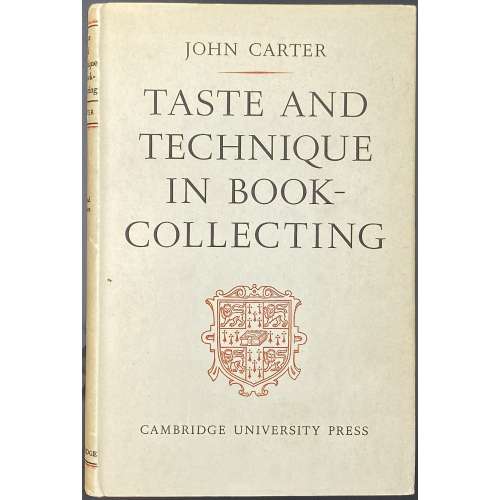 Title: TASTE & TECHNIQUE | IN | BOOK-COLLECTING | A study of recent developments in | Great Britain and the | United States | BY | JOHN CARTER | SANDERS READER IN BIBLIOGRAPHY | AND SOMETIME SCHOLAR OF | KING’S COLLEGE | {space} | {publisher’s device} | CAMBRIDGE | AT THE UNIVERSITY PRESS | 1949 || Half-title: TASTE & TECHNIQUE | IN | BOOK-COLLECTING | The Sanders Lectures in Bibliography | 1947 || Pagination: [i-vi] vii-x [xi] [xii blank], 1-201 [202 blank] [2] – advert. / blank, total 12+202+2=216 pages. Collation: 8vo; π6 1-128, 136, total 108 leaves. Binding: 22.5 x 15 cm, red cloth, gilt lettering to spine, lettered dust-jacket with armorial publisher’s device in red, price-clipped. Edition: 1st edition (1948), 2nd impression, corrected (1949). Contributors: Carter, John Waynflete (British, 1905 – 1975) – author. Cambridge University Press (Cambridge) – publisher. Brooke Crutchley – printer.
Title: TASTE & TECHNIQUE | IN | BOOK-COLLECTING | A study of recent developments in | Great Britain and the | United States | BY | JOHN CARTER | SANDERS READER IN BIBLIOGRAPHY | AND SOMETIME SCHOLAR OF | KING’S COLLEGE | {space} | {publisher’s device} | CAMBRIDGE | AT THE UNIVERSITY PRESS | 1949 || Half-title: TASTE & TECHNIQUE | IN | BOOK-COLLECTING | The Sanders Lectures in Bibliography | 1947 || Pagination: [i-vi] vii-x [xi] [xii blank], 1-201 [202 blank] [2] – advert. / blank, total 12+202+2=216 pages. Collation: 8vo; π6 1-128, 136, total 108 leaves. Binding: 22.5 x 15 cm, red cloth, gilt lettering to spine, lettered dust-jacket with armorial publisher’s device in red, price-clipped. Edition: 1st edition (1948), 2nd impression, corrected (1949). Contributors: Carter, John Waynflete (British, 1905 – 1975) – author. Cambridge University Press (Cambridge) – publisher. Brooke Crutchley – printer. -
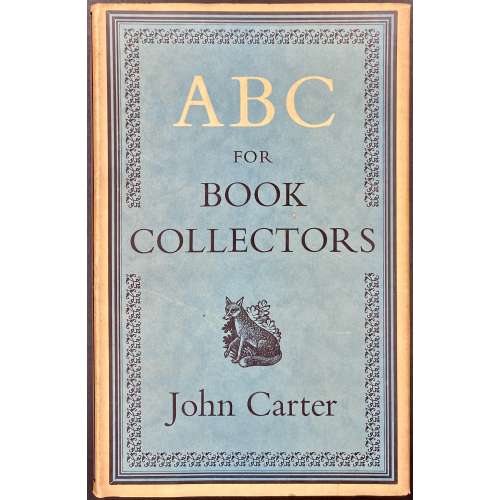 Title: ABC | FOR | BOOK-COLLECTORS | BY | JOHN CARTER | {publisher’s device} | RUPERT HART-DAVIS | SOHO SQUARE LONDON | 1952 | [TITLE-PAGE] || Pagination: [1-6] 7-191 [192 advert.], total number of pages 192. Collation: 8vo; [A]8 B-M8, total number of leaves 96. Binding: 21 x 13.5 cm, aubergine cloth, gilt lettering to spine, pictorial endpapers; cream unclipped (15s. net) dust-jacket with the sea-green panel in a border, with a fleuron frame, black and cream lettering, and publisher’s device to front; lettering to spine and back; folded prospectus insert loose. Edition: 1st. Contributors: Carter, John Waynflete (British, 1905 – 1975) – author Hart-Davis, Sir Rupert Charles (British, 1907 – 1999); Rupert Hart-Davis Ltd. (London) – publisher. Hazell, Watson and Viney, Ltd. – printer.
Title: ABC | FOR | BOOK-COLLECTORS | BY | JOHN CARTER | {publisher’s device} | RUPERT HART-DAVIS | SOHO SQUARE LONDON | 1952 | [TITLE-PAGE] || Pagination: [1-6] 7-191 [192 advert.], total number of pages 192. Collation: 8vo; [A]8 B-M8, total number of leaves 96. Binding: 21 x 13.5 cm, aubergine cloth, gilt lettering to spine, pictorial endpapers; cream unclipped (15s. net) dust-jacket with the sea-green panel in a border, with a fleuron frame, black and cream lettering, and publisher’s device to front; lettering to spine and back; folded prospectus insert loose. Edition: 1st. Contributors: Carter, John Waynflete (British, 1905 – 1975) – author Hart-Davis, Sir Rupert Charles (British, 1907 – 1999); Rupert Hart-Davis Ltd. (London) – publisher. Hazell, Watson and Viney, Ltd. – printer. -
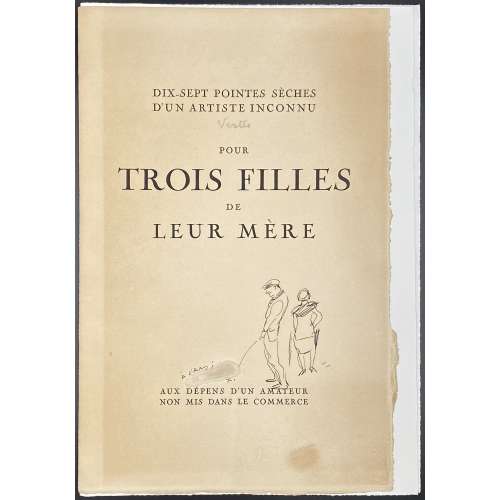 Seventeen drypoint prints in purple plus one original ink sketch by Marcel Vertés (French, 1895 – 1961) – illustrations to the book by Pierre Louÿs Trois filles de leur mère, in a paper folder. Front : DIX-SEPT POINTES SÈCHES | D'UN ARTISTE INCONNU | POUR | TROIS FILLES | DE | LEUR MÈRE | {space} | AUX DÉPENS D'UN AMATEUR | NON MIS DANS LE COMMERCE || Pencil manuscript Vertés under “ARTISTE”, autograph vignette above “AMATEUR”, erased dedication inscription above “DÉPENS” À L’AMI [erased] X. Back: JUSTIFICATION DU TIRAGE | 17 EXEMPLAIRES SUR VÉLIN D’ARCHES CONTENANT | UNE SUITE DES DIX-SEPT POINTES SÈCHES EN | NOIR : UNE SUITE EN COULEURS COLORIÉE PAR | L’ARTISTE ; UN DESSIN ORIGINAL ET SA PLANCHE | DE CUIVRE ; DIX-SEPT CROQUIS ORIGINAUX | MARQUÉS A à Q. | 50 EXEMPLAIRES SUR VÉLIN D’ARCHES CONTE- | NANT UNE SUITE DES DIX-SEPT POINTES | SÈCHES ET TROIS CROQUIS ORIGINAUX | NUMÉROTÉS DE 1 à 50. | {space} | EXEMPLAIRE № {by hand} H. C. || Size : folder 28 x 17.5 cm; sketch 26.6 x 17.6 cm; prints 27.5 x 19 cm. Printed on wove paper with MBM watermark (Arches MBM Paper). Bookplate pasted to the makeshift extra folder with title: “EX-LIBRIS | Jacques | Crepineau”. Provenance: Jacques Crepineau (French, 1932 – 2017). Description by seller: [CURIOSA - VERTÈS (Marcel)]. Dix-sept pointes sèches d'un artiste inconnu pour Trois filles de leur mère. S.l. : Aux dépens d'un amateur, [1927]. — In-8, en feuilles. Dutel 2517*. Rare suite de 17 pointes-sèches libres réalisées par Marcel VERTÈS, probablement publiée par Marcel Cotinaud. Elle était destinée à accompagner l'édition originale de Trois filles de leur mère de Pierre Louÿs publiée un an plus tôt. Tirage à 67 exemplaires sur vélin d'Arches. Les épreuves sont tirées en violet. Exemplaire sans le feuillet de titre, ni celui de la justification. Il comprend un croquis original de l'artiste, non signé, ayant servi d'étude pour l'une des planches. Selon les tirages, chaque exemplaire devrait comprendre 17 croquis pour les 17 premiers, ou 3 pour les 50 autres, non n'en avons ici qu'un seul. Envoi de Vertès sur la couverture, accompagné d'un dessin original. Le nom du destinataire a été effacé. Manque la chemise et l'étui. Description by DUTEL v.3, p. 389, № 2517: In-4 (28 x 19) de 2 ff., 17 pointes sèches, étui, chemise. … publiée en 1927 probablement par Marcel Cotinaud (SV : publisher of Vertés was Paul Cotinaud)… Les planches sont tirées en violet (SV : like this one). Tirage : 17 ex. …avec une suite coloriée par l’artiste, un dessin, un cuivre et 17 croquis. 50 ex. … avec 3 croquis. Other names: Marcel Vertès, Marcel Vertes, Marcell Vértes
Seventeen drypoint prints in purple plus one original ink sketch by Marcel Vertés (French, 1895 – 1961) – illustrations to the book by Pierre Louÿs Trois filles de leur mère, in a paper folder. Front : DIX-SEPT POINTES SÈCHES | D'UN ARTISTE INCONNU | POUR | TROIS FILLES | DE | LEUR MÈRE | {space} | AUX DÉPENS D'UN AMATEUR | NON MIS DANS LE COMMERCE || Pencil manuscript Vertés under “ARTISTE”, autograph vignette above “AMATEUR”, erased dedication inscription above “DÉPENS” À L’AMI [erased] X. Back: JUSTIFICATION DU TIRAGE | 17 EXEMPLAIRES SUR VÉLIN D’ARCHES CONTENANT | UNE SUITE DES DIX-SEPT POINTES SÈCHES EN | NOIR : UNE SUITE EN COULEURS COLORIÉE PAR | L’ARTISTE ; UN DESSIN ORIGINAL ET SA PLANCHE | DE CUIVRE ; DIX-SEPT CROQUIS ORIGINAUX | MARQUÉS A à Q. | 50 EXEMPLAIRES SUR VÉLIN D’ARCHES CONTE- | NANT UNE SUITE DES DIX-SEPT POINTES | SÈCHES ET TROIS CROQUIS ORIGINAUX | NUMÉROTÉS DE 1 à 50. | {space} | EXEMPLAIRE № {by hand} H. C. || Size : folder 28 x 17.5 cm; sketch 26.6 x 17.6 cm; prints 27.5 x 19 cm. Printed on wove paper with MBM watermark (Arches MBM Paper). Bookplate pasted to the makeshift extra folder with title: “EX-LIBRIS | Jacques | Crepineau”. Provenance: Jacques Crepineau (French, 1932 – 2017). Description by seller: [CURIOSA - VERTÈS (Marcel)]. Dix-sept pointes sèches d'un artiste inconnu pour Trois filles de leur mère. S.l. : Aux dépens d'un amateur, [1927]. — In-8, en feuilles. Dutel 2517*. Rare suite de 17 pointes-sèches libres réalisées par Marcel VERTÈS, probablement publiée par Marcel Cotinaud. Elle était destinée à accompagner l'édition originale de Trois filles de leur mère de Pierre Louÿs publiée un an plus tôt. Tirage à 67 exemplaires sur vélin d'Arches. Les épreuves sont tirées en violet. Exemplaire sans le feuillet de titre, ni celui de la justification. Il comprend un croquis original de l'artiste, non signé, ayant servi d'étude pour l'une des planches. Selon les tirages, chaque exemplaire devrait comprendre 17 croquis pour les 17 premiers, ou 3 pour les 50 autres, non n'en avons ici qu'un seul. Envoi de Vertès sur la couverture, accompagné d'un dessin original. Le nom du destinataire a été effacé. Manque la chemise et l'étui. Description by DUTEL v.3, p. 389, № 2517: In-4 (28 x 19) de 2 ff., 17 pointes sèches, étui, chemise. … publiée en 1927 probablement par Marcel Cotinaud (SV : publisher of Vertés was Paul Cotinaud)… Les planches sont tirées en violet (SV : like this one). Tirage : 17 ex. …avec une suite coloriée par l’artiste, un dessin, un cuivre et 17 croquis. 50 ex. … avec 3 croquis. Other names: Marcel Vertès, Marcel Vertes, Marcell Vértes -
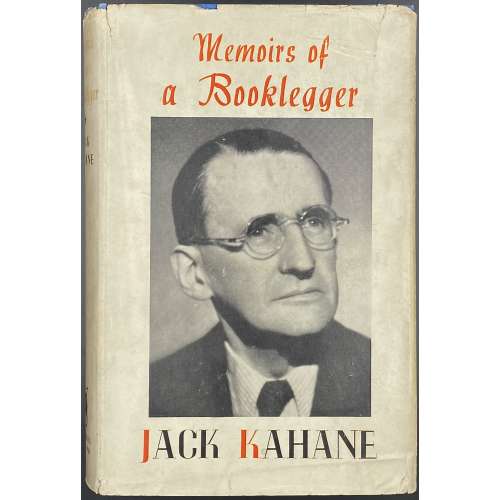 Title: JACK KAHANE | ★ | Memoirs of a | Booklegger | [space] | {publisher’s device} | MICHAEL JOSEPH LTD. | 26, Bloomsbury Street, London, W.C.I || Pagination: [1-6] 7-287 [288 blank]; total 288 pages. Collation: 8vo; [A]8 B-S8; total 144 leaves. Binding: 21.5 x 15 cm, by James Burn, publisher’s blue cloth, silver lettering to spine, yellow endpapers; cream dust-jacket with black and red lettering and reproduced photo portrait of the author. Contributors: Jack Kahane (British, 1887 – 1939) – author. Michael Joseph (British, 1897 – 1958); Michael Joseph Ltd. (London) – publisher. William Brendon & Son, Ltd.; Mayflower Press (Plymouth) – printer. John Dickinson & Co.; John Dickinson (British, 1782 – 1869) – paper maker. Frederick E. Kahane – dedicatee (brother of Jack).
Title: JACK KAHANE | ★ | Memoirs of a | Booklegger | [space] | {publisher’s device} | MICHAEL JOSEPH LTD. | 26, Bloomsbury Street, London, W.C.I || Pagination: [1-6] 7-287 [288 blank]; total 288 pages. Collation: 8vo; [A]8 B-S8; total 144 leaves. Binding: 21.5 x 15 cm, by James Burn, publisher’s blue cloth, silver lettering to spine, yellow endpapers; cream dust-jacket with black and red lettering and reproduced photo portrait of the author. Contributors: Jack Kahane (British, 1887 – 1939) – author. Michael Joseph (British, 1897 – 1958); Michael Joseph Ltd. (London) – publisher. William Brendon & Son, Ltd.; Mayflower Press (Plymouth) – printer. John Dickinson & Co.; John Dickinson (British, 1782 – 1869) – paper maker. Frederick E. Kahane – dedicatee (brother of Jack). -
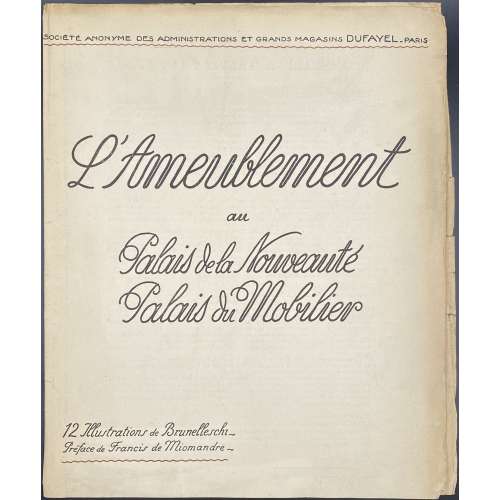 A set of 12 photomechanically reproduced illustrations after gouaches by Umberto Brunelleschi (Italian, 1879 – 1949), in colour; b/w photographs reproductions on verso, in a paper folder without the outer wrappers (b/w with birds, insects, and flowers). Text on the folder by French novelist Francis de Miomandre (French, 1880 – 1959); published by Grands Magasins Dufayel (1856 – 1930), a Parisian department store, run by Georges Dufayel (French, 1855 – 1916). Size: 29 x 24 cm. Images printed on cream paper within a beige frame, lettered above the frame in beige: "Societé Anonyme des Administrations et Grands Magasins DUFAYEL — Paris —", under the frame: "Palais de la Nouveauté ~ Palais du Mobilier | Entrée principale 7 Bould BARBES"; at the bottom of the frame lettered black on each image: Le Style Chinois, Le Style Empire, Le Style Japonais, Le Style Louis XIV, Le Style Louis XV, Le Style Louis XVI, Le Style Moderne (2), Le Style Moyen Age, Le Style Renaissance, Le Style Vénitien, Le Style Persian.
A set of 12 photomechanically reproduced illustrations after gouaches by Umberto Brunelleschi (Italian, 1879 – 1949), in colour; b/w photographs reproductions on verso, in a paper folder without the outer wrappers (b/w with birds, insects, and flowers). Text on the folder by French novelist Francis de Miomandre (French, 1880 – 1959); published by Grands Magasins Dufayel (1856 – 1930), a Parisian department store, run by Georges Dufayel (French, 1855 – 1916). Size: 29 x 24 cm. Images printed on cream paper within a beige frame, lettered above the frame in beige: "Societé Anonyme des Administrations et Grands Magasins DUFAYEL — Paris —", under the frame: "Palais de la Nouveauté ~ Palais du Mobilier | Entrée principale 7 Bould BARBES"; at the bottom of the frame lettered black on each image: Le Style Chinois, Le Style Empire, Le Style Japonais, Le Style Louis XIV, Le Style Louis XV, Le Style Louis XVI, Le Style Moderne (2), Le Style Moyen Age, Le Style Renaissance, Le Style Vénitien, Le Style Persian. -
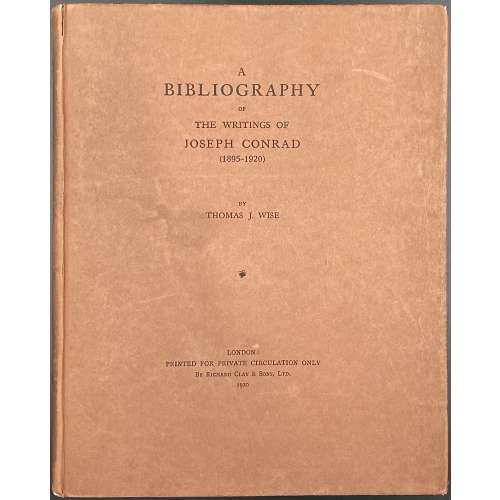 Title page: A | BIBLIOGRAPHY | OF | THE WRITINGS OF | JOSEPH CONRAD (1895–1920) | BY THOMAS J. WISE | ❦ | LONDON: | PRINTED FOR PRIVATE CIRCULATION ONLY | By Richard Clay & Sons, Ltd. | 1920 || Pagination: [i-viii] ix-xiii [xiv-xvi], [1, 2] 3-105 [106-112], frontispiece with tissue guard in collation; 128 pages total. Collation: 8vo; [A]-H8, 64 leaves total. Binding: 22.5 x 18 cm; terracotta paper boards, black lettering to front and spine; uncut. The device on the recto of the last leaf inscribed: The Ashley library. Privately printed. 1920. Insert: ALS from Thomas J. Wise dated 22/3/21 on watermarked paper (King of Kent | Extra Fine) with letterhead “Kirkstead”, 25 Heath Drive, Hampstead, N.W.3. The letter is a response to a request for two copies of Volume II of Wise’s Swinburne bibliography, which Wise promises to supply the next day to Stevens & Brown (founded in 1864, Literary and Fine Arts Agents). Limitation: 150 copies, private printing. Contributors: Joseph Conrad [Józef Teodor Konrad Korzeniowski] (British-Polish, 1857 – 1924) Wise, Thomas James (British, 1859 – 1937) – compiler, bibliographer. R. Clay & Sons Ltd. (London); Clay, Richard (British, 1789 – 1877) – publisher. The Ashley Library (London) – printer.
Title page: A | BIBLIOGRAPHY | OF | THE WRITINGS OF | JOSEPH CONRAD (1895–1920) | BY THOMAS J. WISE | ❦ | LONDON: | PRINTED FOR PRIVATE CIRCULATION ONLY | By Richard Clay & Sons, Ltd. | 1920 || Pagination: [i-viii] ix-xiii [xiv-xvi], [1, 2] 3-105 [106-112], frontispiece with tissue guard in collation; 128 pages total. Collation: 8vo; [A]-H8, 64 leaves total. Binding: 22.5 x 18 cm; terracotta paper boards, black lettering to front and spine; uncut. The device on the recto of the last leaf inscribed: The Ashley library. Privately printed. 1920. Insert: ALS from Thomas J. Wise dated 22/3/21 on watermarked paper (King of Kent | Extra Fine) with letterhead “Kirkstead”, 25 Heath Drive, Hampstead, N.W.3. The letter is a response to a request for two copies of Volume II of Wise’s Swinburne bibliography, which Wise promises to supply the next day to Stevens & Brown (founded in 1864, Literary and Fine Arts Agents). Limitation: 150 copies, private printing. Contributors: Joseph Conrad [Józef Teodor Konrad Korzeniowski] (British-Polish, 1857 – 1924) Wise, Thomas James (British, 1859 – 1937) – compiler, bibliographer. R. Clay & Sons Ltd. (London); Clay, Richard (British, 1789 – 1877) – publisher. The Ashley Library (London) – printer. -
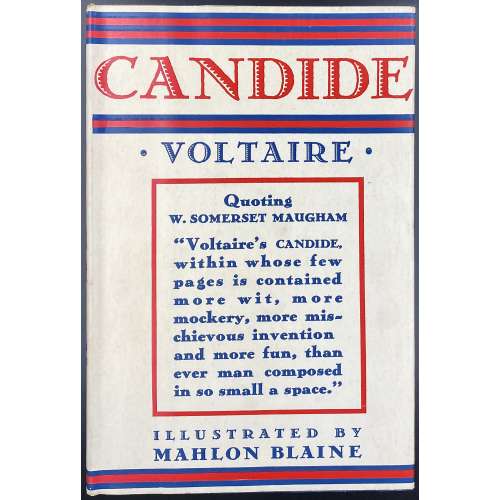 Title (chain border): CANDIDE | VOLTAIRE | ILLUSTRATIONS BY | MAHLON BLAINE | {vignette} | NEW YORK | Illustrated Editions Company | 220 FOURTH AVENUE || Title verso: (top) COPYRIGHT, 1930, BY WILLIAMS, BELASCO & MEYERS || (bottom) PRINTED IN THE UNITED STATES OF AMERICA | BY J. J. LITTLE & IVES COMPANY, NEW YORK || Pagination:[1-7] 8-144, headpiece, frontispiece and 5 plates after Blaine’s pen drawings, within the pagination; tailpieces by A. Zaidenberg. Binding: 21 x 14 cm; quarter beige buckram over blue cloth, stamped-gilt and red lettering and vignette to front board and spine. Binding in a way similar to Sterne's A sentimental journey published by Three Sirens Press in c. 1930 [LIB-2784.2021]. Not only that: tailpieces in this Illustrated Editions Company edition are the same as in Cameo Classic edition, with the only difference – here the name of the artist is stated, whether in the Cameo Classic it is not; see [LIB-2777.2021]. Bear in mind that Cameo Classic does not belong to Williams, Belasco and Meyers, it is a Grosset and Dunlap series; a cream dust-jacket lettered in red and blue, and with a citation from W. Somerset Maugham; all edges red. Compare with LIB-2791.2021. Illustrations in the current copy are exactly the same. Compare Williams, Belasco and Meyers Candide and Illustrated Editions Company Candide title pages:
Title (chain border): CANDIDE | VOLTAIRE | ILLUSTRATIONS BY | MAHLON BLAINE | {vignette} | NEW YORK | Illustrated Editions Company | 220 FOURTH AVENUE || Title verso: (top) COPYRIGHT, 1930, BY WILLIAMS, BELASCO & MEYERS || (bottom) PRINTED IN THE UNITED STATES OF AMERICA | BY J. J. LITTLE & IVES COMPANY, NEW YORK || Pagination:[1-7] 8-144, headpiece, frontispiece and 5 plates after Blaine’s pen drawings, within the pagination; tailpieces by A. Zaidenberg. Binding: 21 x 14 cm; quarter beige buckram over blue cloth, stamped-gilt and red lettering and vignette to front board and spine. Binding in a way similar to Sterne's A sentimental journey published by Three Sirens Press in c. 1930 [LIB-2784.2021]. Not only that: tailpieces in this Illustrated Editions Company edition are the same as in Cameo Classic edition, with the only difference – here the name of the artist is stated, whether in the Cameo Classic it is not; see [LIB-2777.2021]. Bear in mind that Cameo Classic does not belong to Williams, Belasco and Meyers, it is a Grosset and Dunlap series; a cream dust-jacket lettered in red and blue, and with a citation from W. Somerset Maugham; all edges red. Compare with LIB-2791.2021. Illustrations in the current copy are exactly the same. Compare Williams, Belasco and Meyers Candide and Illustrated Editions Company Candide title pages: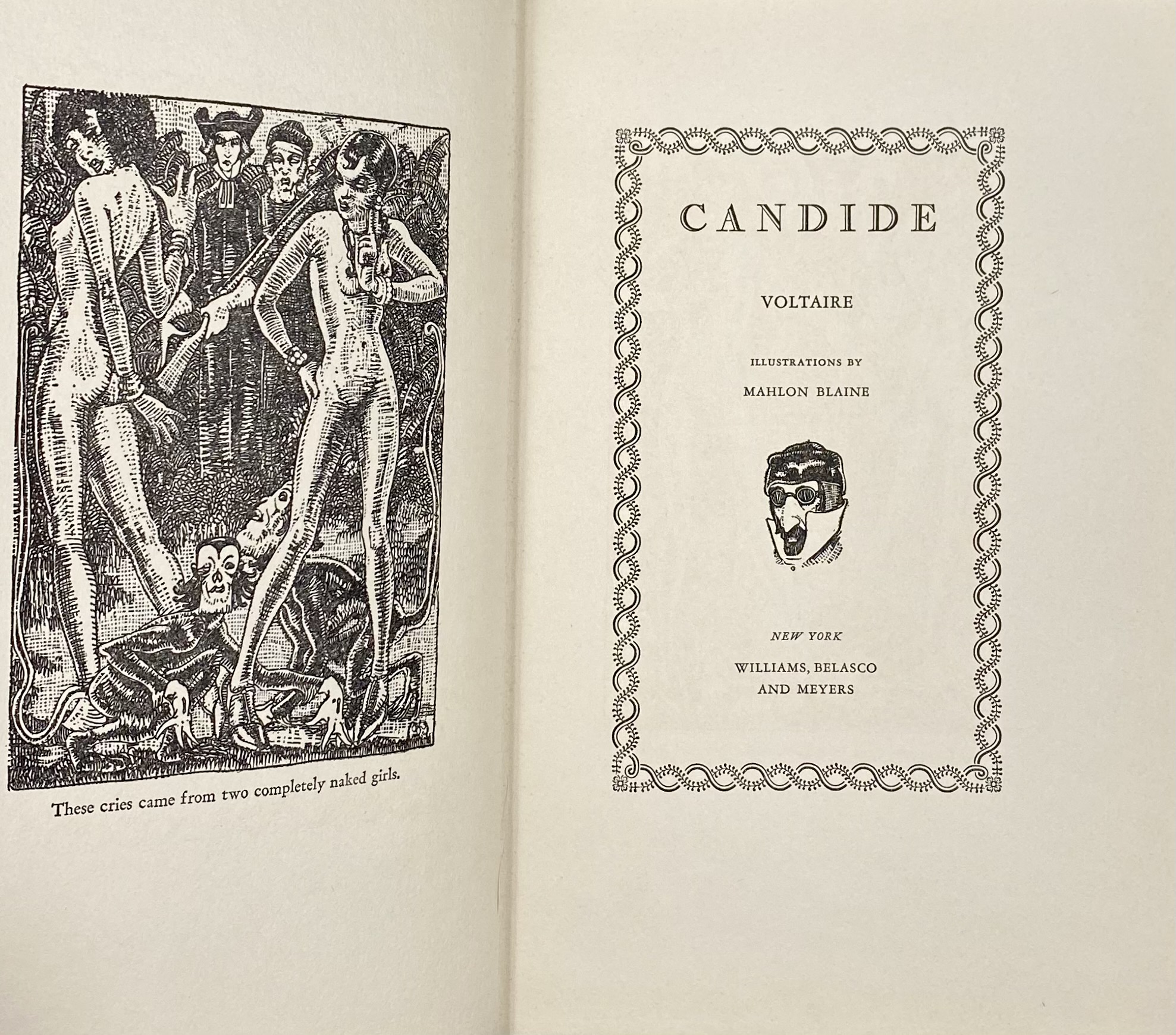
Williams, Belasco and Meyers
Arouet, François-Marie [Voltaire] (French, 1694 – 1778)– author. Woolf, Herman Irwell [Chambers, Dorset] (British, 1890 – 1958) – translator. Blaine, Mahlon [Hudson, G. Christopher] (American, 1894 – 1969) – illustrator. Zaidenberg, Arthur (American, 1902 – 1990) – illustrator. Williams, Belasco and Meyers (NY) – copyright holder. Illustrated Editions Company (1929-1942) – publisher. J. J. Little & Ives Company (NY) – printer. See the Cameo Classic reprint [LIB-2777.2021].
Illustrated Editions Company
-
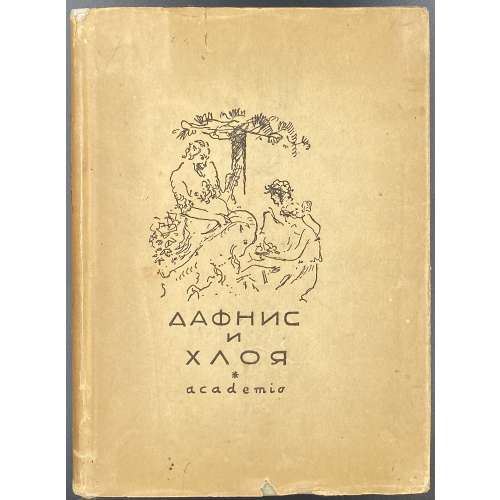 Title page: ЛОНГ | ДАФНИС И ХЛОЯ | Вступительная статья, | перевод и комментарии | С. П. Кондратьева | ACADEMIA | 1935 || Opposite title: АНТИЧНАЯ ЛИТЕРАТУРА | под общей редакцией | Д. А. Горбова, В. О. Нилендера | и П. Ф. Преображенского | ЛОНГ | (III—IV век н. э.) | ACADEMIA | Москва—Ленинград || Title verso: ΛΌΓΓΟΥ | Ποιμενικών των κατά Δάφνιν και Χλόην | Λόγοι τέτταρες | LONGI | Pastoralium de Daphnide et Chloë | libri quattuor | Рисунки, заставки, концовки, переплет и супер-обложка В. Г. Бехтеева || Pagination: [i-vi] vii-xx [2], [1, 2] 3-196 [2], 220 pages total, plus frontispiece in colour extra to collation; and 13 b/w plates within collation, headpieces after Бехтеев, Владимир Георгиевич (Russian, 1878 – 1971). Collation: i8 ii3, 1-128 133 = 110 leaves plus 1 plate. Binding: 17.5 x 13 cm, grey cloth, vignette to front board, lettering to spine, pictorial dust-jacket. Print run: 5,300 copies. Catalogue raisonné: В. В. Крылов, Е. В. Кичатова (2004): № 744, p. 265. Contributors: Longus [Лонг, Λόγγος] (Greek, 2nd century AD) – author. Кондратьев, Сергей Петрович (Russian, 1872 – 1964) – translator. Бехтеев, Владимир Георгиевич (Russian, 1878 – 1971) – artist. Other titles: Daphnis and Chloe (en), Daphnis et Chloé (fr), Daphnis und Chloe (de), Dafnis y Cloe (es), Gli amori pastorali di Dafni e Cloe (it).
Title page: ЛОНГ | ДАФНИС И ХЛОЯ | Вступительная статья, | перевод и комментарии | С. П. Кондратьева | ACADEMIA | 1935 || Opposite title: АНТИЧНАЯ ЛИТЕРАТУРА | под общей редакцией | Д. А. Горбова, В. О. Нилендера | и П. Ф. Преображенского | ЛОНГ | (III—IV век н. э.) | ACADEMIA | Москва—Ленинград || Title verso: ΛΌΓΓΟΥ | Ποιμενικών των κατά Δάφνιν και Χλόην | Λόγοι τέτταρες | LONGI | Pastoralium de Daphnide et Chloë | libri quattuor | Рисунки, заставки, концовки, переплет и супер-обложка В. Г. Бехтеева || Pagination: [i-vi] vii-xx [2], [1, 2] 3-196 [2], 220 pages total, plus frontispiece in colour extra to collation; and 13 b/w plates within collation, headpieces after Бехтеев, Владимир Георгиевич (Russian, 1878 – 1971). Collation: i8 ii3, 1-128 133 = 110 leaves plus 1 plate. Binding: 17.5 x 13 cm, grey cloth, vignette to front board, lettering to spine, pictorial dust-jacket. Print run: 5,300 copies. Catalogue raisonné: В. В. Крылов, Е. В. Кичатова (2004): № 744, p. 265. Contributors: Longus [Лонг, Λόγγος] (Greek, 2nd century AD) – author. Кондратьев, Сергей Петрович (Russian, 1872 – 1964) – translator. Бехтеев, Владимир Георгиевич (Russian, 1878 – 1971) – artist. Other titles: Daphnis and Chloe (en), Daphnis et Chloé (fr), Daphnis und Chloe (de), Dafnis y Cloe (es), Gli amori pastorali di Dafni e Cloe (it). -
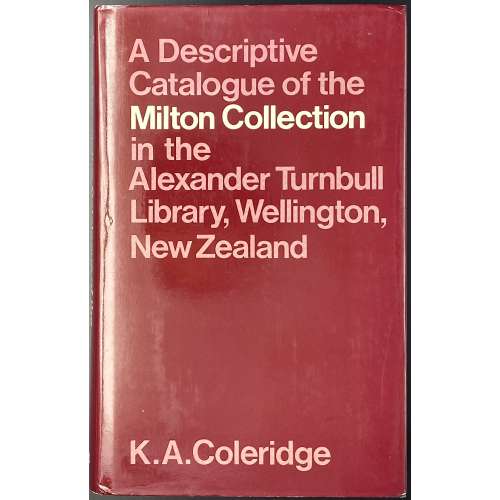 Title page: A DESCRIPTIVE CATALOGUE | OF THE | MILTON COLLECTION | IN THE ALEXANDER | TURNBULL LIBRARY, | WELLINGTON, | NEW ZEALAND |Describing works printed before 1801 | held in the Library at December 1975 | COMPILED BY | K. A. COLERIDGE | Published for the Alexander Turnbull Library, | National Library of New Zealand, | by OXFORD UNIVERSITY PRESS | 1980. Pagination: [i-v] vi-xxv [xxvi blank], [1] 2-536, plus 27 leaves with 60 plates. Printer: Printed in Great Britain at the Pitman Press, Bath. Size: 22.5 x 14.5 cm. Binding: Black cloth, gilt lettering to spine, lettered maroon dust-jacket, unclipped (£35.00 net in UK). Contributor: Kathleen A. Coleridge (New Zealand, b. 1944).
Title page: A DESCRIPTIVE CATALOGUE | OF THE | MILTON COLLECTION | IN THE ALEXANDER | TURNBULL LIBRARY, | WELLINGTON, | NEW ZEALAND |Describing works printed before 1801 | held in the Library at December 1975 | COMPILED BY | K. A. COLERIDGE | Published for the Alexander Turnbull Library, | National Library of New Zealand, | by OXFORD UNIVERSITY PRESS | 1980. Pagination: [i-v] vi-xxv [xxvi blank], [1] 2-536, plus 27 leaves with 60 plates. Printer: Printed in Great Britain at the Pitman Press, Bath. Size: 22.5 x 14.5 cm. Binding: Black cloth, gilt lettering to spine, lettered maroon dust-jacket, unclipped (£35.00 net in UK). Contributor: Kathleen A. Coleridge (New Zealand, b. 1944). -
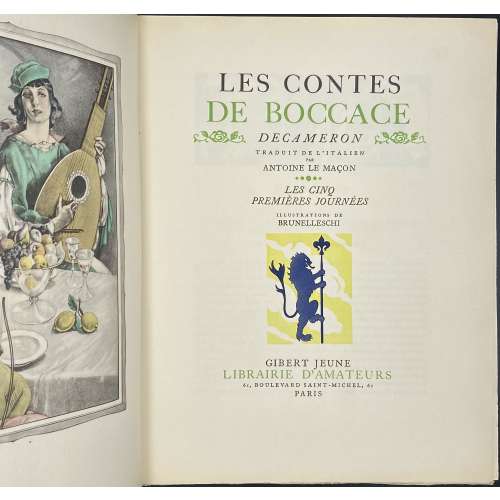 Vol. 1: Front cover and title page: LES CONTES | DE BOCCACE | ☙ DECAMERON ❧ | TRADUIT DE L'ITALIEN | PAR | ANTOINE LE MAÇON | LES CINQ | PREMIÈRES JOURNÉES | ILLUSTRATIONS DE | BRUNELLESCHI | {vignette} | GIBERT JEUNE | LIBRAIRIE D'AMATEURS | 61, BOULEVARD SAINT-MICHEL, 61 | PARIS || Pagination: [6] 1-342 [343-4] [10], 16 colour plates and 70 b/w head- and tailpieces after Umberto Brunelleschi. Vol. 2: Front cover and title page: LES CONTES | DE BOCCACE | ☙ DECAMERON ❧ | TRADUIT DE L'ITALIEN | PAR | ANTOINE LE MAÇON | LES CINQ | DERNIÈRES JOURNÉES | ILLUSTRATIONS DE | BRUNELLESCHI | {vignette} | GIBERT JEUNE | LIBRAIRIE D'AMATEURS | 61, BOULEVARD SAINT-MICHEL, 61 | PARIS || Pagination: [6] 1-281 [282] [10], 16 colour plates and 68 b/w head- and tailpieces after Umberto Brunelleschi. Edition: Limited to 2,500 copies, of which this is № 1. Edition supplemented with two full extra sets of plates, 32 in black and white, and 32 in colour. Printed on June 25, 1934. Binding: 26.5 x 20.5 cm; cream flapped wrappers (French softcover) with green and black lettering and vignettes to front cover and spine, publisher’s device on the back; uncut copy. Paper: Vélin de Navarre (wove paper), size: 260 x 200 mm. Contributors: Giovanni Boccaccio (Italian, 1313 – 1375) – author. Antoine Le Maçon (French, c. 1500 – 1559) – translator. Umberto Brunelleschi (Italian, 1879 – 1949) – artist. Malexis, Louis (French, 20 century) – mise en page. Coulouma, Robert (French, 1887 – 1976), Imprimerie Coulouma (Argenteuil) – printer, H. Barthélemy – director. Dantan, A. – engraver (probably from the family of Edouard Joseph Dantan (French, 1848 – 1897) Charpentier, E. – colour au pochoir. Compare this copy with a small one-volume reprint of 1941: [LIB-2773.2021]. Description of the stensil (au pochoir) technique.
Vol. 1: Front cover and title page: LES CONTES | DE BOCCACE | ☙ DECAMERON ❧ | TRADUIT DE L'ITALIEN | PAR | ANTOINE LE MAÇON | LES CINQ | PREMIÈRES JOURNÉES | ILLUSTRATIONS DE | BRUNELLESCHI | {vignette} | GIBERT JEUNE | LIBRAIRIE D'AMATEURS | 61, BOULEVARD SAINT-MICHEL, 61 | PARIS || Pagination: [6] 1-342 [343-4] [10], 16 colour plates and 70 b/w head- and tailpieces after Umberto Brunelleschi. Vol. 2: Front cover and title page: LES CONTES | DE BOCCACE | ☙ DECAMERON ❧ | TRADUIT DE L'ITALIEN | PAR | ANTOINE LE MAÇON | LES CINQ | DERNIÈRES JOURNÉES | ILLUSTRATIONS DE | BRUNELLESCHI | {vignette} | GIBERT JEUNE | LIBRAIRIE D'AMATEURS | 61, BOULEVARD SAINT-MICHEL, 61 | PARIS || Pagination: [6] 1-281 [282] [10], 16 colour plates and 68 b/w head- and tailpieces after Umberto Brunelleschi. Edition: Limited to 2,500 copies, of which this is № 1. Edition supplemented with two full extra sets of plates, 32 in black and white, and 32 in colour. Printed on June 25, 1934. Binding: 26.5 x 20.5 cm; cream flapped wrappers (French softcover) with green and black lettering and vignettes to front cover and spine, publisher’s device on the back; uncut copy. Paper: Vélin de Navarre (wove paper), size: 260 x 200 mm. Contributors: Giovanni Boccaccio (Italian, 1313 – 1375) – author. Antoine Le Maçon (French, c. 1500 – 1559) – translator. Umberto Brunelleschi (Italian, 1879 – 1949) – artist. Malexis, Louis (French, 20 century) – mise en page. Coulouma, Robert (French, 1887 – 1976), Imprimerie Coulouma (Argenteuil) – printer, H. Barthélemy – director. Dantan, A. – engraver (probably from the family of Edouard Joseph Dantan (French, 1848 – 1897) Charpentier, E. – colour au pochoir. Compare this copy with a small one-volume reprint of 1941: [LIB-2773.2021]. Description of the stensil (au pochoir) technique. -
![Owen E. Holloway. French Rococo Book Illustration. – London: Alec Tiranti, 1969. – pp.: ffl [2 blanks] [i-iv] v-vi, 1-283, bfl.](https://varshavskycollection.com/wp-content/uploads/2021/02/LIB-2526.2020-d-500x500.jpeg) Title page (in red and black): FRENCH ROCOCO | BOOK ILLUSTRATION | OWEN E. HOLLOWAY | {vignette} | LONDON/ALEC TIRANTI/1969 || Series: Pagination: [2 blanks], [i-iv] v-vi, 1-115 [116 blank], plus 65 leaves of plates (283 illustrations). Binding: 25.5 x 19 cm; publisher's navy buckram, gilt lettering to spine, pictorial dust jacket, unclipped.
Title page (in red and black): FRENCH ROCOCO | BOOK ILLUSTRATION | OWEN E. HOLLOWAY | {vignette} | LONDON/ALEC TIRANTI/1969 || Series: Pagination: [2 blanks], [i-iv] v-vi, 1-115 [116 blank], plus 65 leaves of plates (283 illustrations). Binding: 25.5 x 19 cm; publisher's navy buckram, gilt lettering to spine, pictorial dust jacket, unclipped. -
![Gordon N. Ray. The Art of the French Illustrated Book 1700 to 1914 (2 vol. set). — NY, London: The Pierpont Morgan Library; Cornell University Press, 1982. — pp.: vol.1: [8] ix-xxxii, [2] 3-245 [3]; vol.2: [8] 247-557 [5], illustr.](https://varshavskycollection.com/wp-content/uploads/2021/02/LIB-2424.2020-scaled-500x500.jpeg) Title page: The Art of the | French Illustrated Book | 1700 to 1914 | VOLUME I (II) | Gordon N. Ray | The Pierpont Morgan Library | Cornell University Press || Pagination: vol.1: [8] ix-xxxii, [2] 3-245 [3], illustr.; vol.2: [8] 247-557 [5], illustr. Both volumes paginater through out. Binding: 30.5 x 23.5 cm, two volumes uniformly bound in red cloth, gilt vignette to front cover, gilt lettering to spine; bookplate to front pastedown, ex-lib (Sweet Briar College Library) Contributors: Ray, Gordon Norton (American, 1915 – 1986) – author. Lange, Thomas V. – formal bibliographical description. Passela, Charles V. – photography. The Pierpont Morgan Library – Copyright © 1982
Title page: The Art of the | French Illustrated Book | 1700 to 1914 | VOLUME I (II) | Gordon N. Ray | The Pierpont Morgan Library | Cornell University Press || Pagination: vol.1: [8] ix-xxxii, [2] 3-245 [3], illustr.; vol.2: [8] 247-557 [5], illustr. Both volumes paginater through out. Binding: 30.5 x 23.5 cm, two volumes uniformly bound in red cloth, gilt vignette to front cover, gilt lettering to spine; bookplate to front pastedown, ex-lib (Sweet Briar College Library) Contributors: Ray, Gordon Norton (American, 1915 – 1986) – author. Lange, Thomas V. – formal bibliographical description. Passela, Charles V. – photography. The Pierpont Morgan Library – Copyright © 1982 -
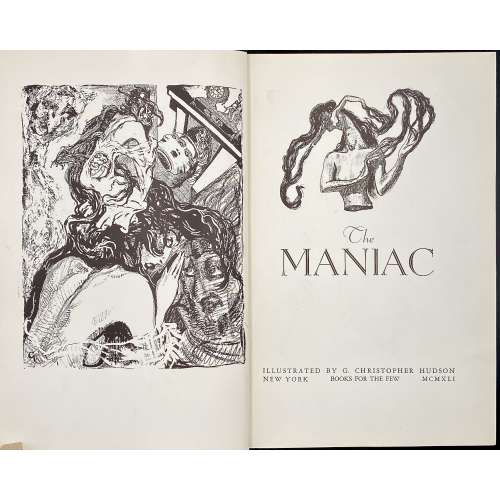 Title page: {vignette} | The | MANIAC | ILLUSTRATED BY G. CHRISTOPHER HUDSON | NEW YORK BOOKS FOR THE FEW MCMXLI || Pagination: [1-6] 7-245 [246], full-page plates and in-text vignettes after Mahlon Blaine drawings. Edition: Limited edition of 1050 copies, this one unnumbered. Text – a reprint of the 1909 edition by Rebman (London); 1st edition, thus. Binding: 24 x 16 cm, black moire cloth, green label with black lettering “THE | MANIAC” to spine. Ink stamp “Charles M. Collins, Jr” to front pastedown. Contributors: E. Thelmar (British, fl. c. 1909) – author; a British journalist, who had been committed to an asylum in 1905; nothing else is known. G. Christopher Hudson [Mahlon Blaine] (American, 1894 – 1969) – artist. Books for the Few (NY) – publisher. Ref: TAYLOR, NICK. “Mahlon Blaine, John Steinbeck, and ‘The Maniac’ (1941).” The Steinbeck Review 9, no. 1 (2012): 73–84. http://www.jstor.org/stable/41582924.
Title page: {vignette} | The | MANIAC | ILLUSTRATED BY G. CHRISTOPHER HUDSON | NEW YORK BOOKS FOR THE FEW MCMXLI || Pagination: [1-6] 7-245 [246], full-page plates and in-text vignettes after Mahlon Blaine drawings. Edition: Limited edition of 1050 copies, this one unnumbered. Text – a reprint of the 1909 edition by Rebman (London); 1st edition, thus. Binding: 24 x 16 cm, black moire cloth, green label with black lettering “THE | MANIAC” to spine. Ink stamp “Charles M. Collins, Jr” to front pastedown. Contributors: E. Thelmar (British, fl. c. 1909) – author; a British journalist, who had been committed to an asylum in 1905; nothing else is known. G. Christopher Hudson [Mahlon Blaine] (American, 1894 – 1969) – artist. Books for the Few (NY) – publisher. Ref: TAYLOR, NICK. “Mahlon Blaine, John Steinbeck, and ‘The Maniac’ (1941).” The Steinbeck Review 9, no. 1 (2012): 73–84. http://www.jstor.org/stable/41582924. -
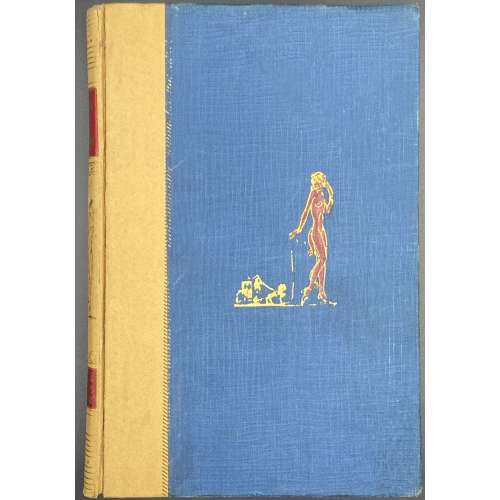 Title (chain border): CANDIDE | VOLTAIRE | ILLUSTRATIONS BY | MAHLON BLAINE | {vignette} | NEW YORK | Illustrated Editions Company | 220 FOURTH AVENUE || Title verso: (top) COPYRIGHT, 1930, BY WILLIAMS, BELASCO & MEYERS || (bottom) PRINTED IN THE UNITED STATES OF AMERICA | BY J. J. LITTLE & IVES COMPANY, NEW YORK || Pagination:[1-10] 11-144, headpiece, frontispiece and 5 plates after Blaine’s pen drawings, within the pagination; tailpieces by A. Zaidenberg. Binding: 21 x 14 cm; quarter beige buckram over blue cloth, stamped-gilt and red lettering and vignette to front board and spine. Binding in a way similar to Sterne's A sentimental journey published by Three Sirens Press in c. 1930 [LIB-2784.2021]. Not only that: tailpieces in this Illustrated Editions Company edition are the same as in Cameo Classic edition, with the only difference – here the name of the artist is stated, whether in the Cameo Classic it is not; see [LIB-2777.2021]. Bear in mind that Cameo Classic does not belong to Williams, Belasco and Meyers, it is a Grosset and Dunlap series. Compare Williams, Belasco and Meyers Candide and Illustrated Editions Company Candide title pages:
Title (chain border): CANDIDE | VOLTAIRE | ILLUSTRATIONS BY | MAHLON BLAINE | {vignette} | NEW YORK | Illustrated Editions Company | 220 FOURTH AVENUE || Title verso: (top) COPYRIGHT, 1930, BY WILLIAMS, BELASCO & MEYERS || (bottom) PRINTED IN THE UNITED STATES OF AMERICA | BY J. J. LITTLE & IVES COMPANY, NEW YORK || Pagination:[1-10] 11-144, headpiece, frontispiece and 5 plates after Blaine’s pen drawings, within the pagination; tailpieces by A. Zaidenberg. Binding: 21 x 14 cm; quarter beige buckram over blue cloth, stamped-gilt and red lettering and vignette to front board and spine. Binding in a way similar to Sterne's A sentimental journey published by Three Sirens Press in c. 1930 [LIB-2784.2021]. Not only that: tailpieces in this Illustrated Editions Company edition are the same as in Cameo Classic edition, with the only difference – here the name of the artist is stated, whether in the Cameo Classic it is not; see [LIB-2777.2021]. Bear in mind that Cameo Classic does not belong to Williams, Belasco and Meyers, it is a Grosset and Dunlap series. Compare Williams, Belasco and Meyers Candide and Illustrated Editions Company Candide title pages:
Williams, Belasco and Meyers
Arouet, François-Marie [Voltaire] (French, 1694 – 1778)– author. Woolf, Herman Irwell [Chambers, Dorset] (British, 1890 – 1958) – translator. Blaine, Mahlon [Hudson, G. Christopher] (American, 1894 – 1969) – illustrator. Zaidenberg, Arthur (American, 1902 – 1990) – illustrator. Williams, Belasco and Meyers (NY) – copyright holder. Illustrated Editions Company (1929-1942) – publisher. J. J. Little & Ives Company (NY) – printer. See the Cameo Classic reprint [LIB-2777.2021].
Illustrated Editions Company
-
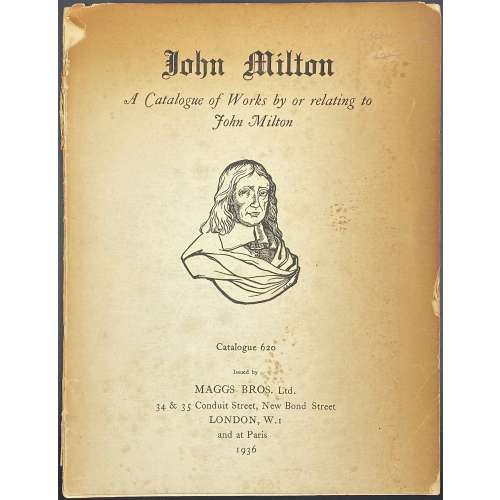 Cover: John Milton | A Catalogue of Works by or Relating to | John Milton | {vignette portrait} | Catalogue 620 | Issued by | MAGGS BROS. Ltd. | 34 & 35 Conduit Street, New Bond Street | LONDON, W.I. | and at Paris | 1936 || Title page: top left: Catalogue 620; top right: 1936, middle: JOHN MILTON | A CATALOGUE OF WORKS BY OR | RELATING TO JOHN MILTON | Largely comprising the Library of the well-known Milton Scholar, the late | prof. Hugh C. H. Candy, B.A., B Sc. | {coat of arms: by appointment to his majesty King George V} | MAGGS BROS. Ltd. | BOOKSELLERS BY APPOINTMENT TO HIS MAJESTY KING GEORGE V | AND H.R.H. THE PRINCE OF WALES | 34 & 35 CONDUIT STREET, LONDON, W.I. | TELEGRAPHIC & CABLE ADDRESS: “BIBLIOLITE, LONDON.” […] TEL.: REGENT 1337 | At Paris: Maggs Bros., 93 & 95 Rue La Boëtie. || Printed: Courier Press Leamington SPA and London. Pagination: [1-4] 5-56 [6], wrappers incl. in pagination, the total number of leaves is 31. Binding: 24 x 18.5 cm, publisher’s tan wrappers, front wrapper detached, browned.
Cover: John Milton | A Catalogue of Works by or Relating to | John Milton | {vignette portrait} | Catalogue 620 | Issued by | MAGGS BROS. Ltd. | 34 & 35 Conduit Street, New Bond Street | LONDON, W.I. | and at Paris | 1936 || Title page: top left: Catalogue 620; top right: 1936, middle: JOHN MILTON | A CATALOGUE OF WORKS BY OR | RELATING TO JOHN MILTON | Largely comprising the Library of the well-known Milton Scholar, the late | prof. Hugh C. H. Candy, B.A., B Sc. | {coat of arms: by appointment to his majesty King George V} | MAGGS BROS. Ltd. | BOOKSELLERS BY APPOINTMENT TO HIS MAJESTY KING GEORGE V | AND H.R.H. THE PRINCE OF WALES | 34 & 35 CONDUIT STREET, LONDON, W.I. | TELEGRAPHIC & CABLE ADDRESS: “BIBLIOLITE, LONDON.” […] TEL.: REGENT 1337 | At Paris: Maggs Bros., 93 & 95 Rue La Boëtie. || Printed: Courier Press Leamington SPA and London. Pagination: [1-4] 5-56 [6], wrappers incl. in pagination, the total number of leaves is 31. Binding: 24 x 18.5 cm, publisher’s tan wrappers, front wrapper detached, browned. -
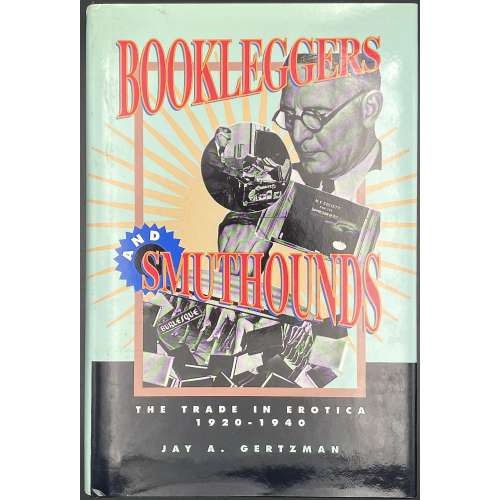 Title page: BOOKLEGGERS | AND | SMUTHOUNDS | THE TRADE IN EROTICA, 1920-1940 | JAY A. GERTZMAN | UNIVERSITY OF PENNSYLVANIA PRESS • PHILADELPHIA || Pagination: [8] [1] 2-418 [6] blanks, total 216 leaves. Binding: 24.5 x 16 cm; black cloth, silver lettering to spine, pictorial dust jacket.
Title page: BOOKLEGGERS | AND | SMUTHOUNDS | THE TRADE IN EROTICA, 1920-1940 | JAY A. GERTZMAN | UNIVERSITY OF PENNSYLVANIA PRESS • PHILADELPHIA || Pagination: [8] [1] 2-418 [6] blanks, total 216 leaves. Binding: 24.5 x 16 cm; black cloth, silver lettering to spine, pictorial dust jacket. -
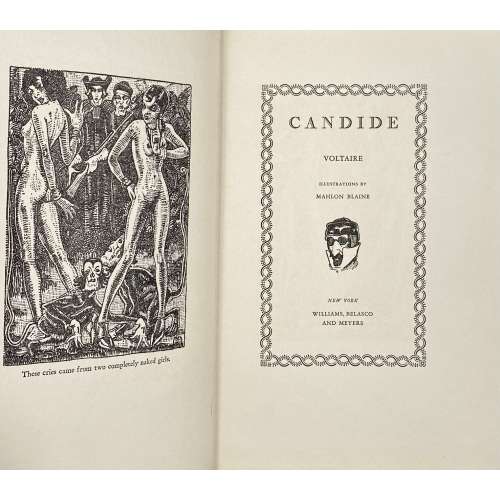 Title (chain border): CANDIDE | VOLTAIRE | ILLUSTRATIONS BY | MAHLON BLAINE | {vignette} | NEW YORK | WILLIAMS, BELASCO | AND MEYERS || Title verso: (top) COPYRIGHT, 1930, BY WILLIAMS, BELASCO & MEYERS || (bottom) PRINTED IN THE UNITED STATES OF AMERICA | BY J. J. LITTLE & IVES COMPANY, NEW YORK || Pagination:[1-6] 7-144, headpiece, frontispiece and 5 plates after Blaine’s pen drawings, within the pagination. Binding: 25 x 16.5 cm; blue cloth, blind-stamped frame, stamped-gilt lettering to front board and spine, thick wove paper, upper edge blue, fore-edge untrimmed, yellow vergé endpapers. Arouet, François-Marie [Voltaire] (French, 1694 – 1778)– author. Woolf, Herman Irwell [Chambers, Dorset] (British, 1890 – 1958) – translator. Blaine, Mahlon [Hudson, G. Christopher] (American, 1894 – 1969) – illustrator. Williams, Belasco and Meyers (NY) – publisher. J. J. Little & Ives Company (NY) – printer. See the Cameo Classic reprint [LIB-2777.2021].
Title (chain border): CANDIDE | VOLTAIRE | ILLUSTRATIONS BY | MAHLON BLAINE | {vignette} | NEW YORK | WILLIAMS, BELASCO | AND MEYERS || Title verso: (top) COPYRIGHT, 1930, BY WILLIAMS, BELASCO & MEYERS || (bottom) PRINTED IN THE UNITED STATES OF AMERICA | BY J. J. LITTLE & IVES COMPANY, NEW YORK || Pagination:[1-6] 7-144, headpiece, frontispiece and 5 plates after Blaine’s pen drawings, within the pagination. Binding: 25 x 16.5 cm; blue cloth, blind-stamped frame, stamped-gilt lettering to front board and spine, thick wove paper, upper edge blue, fore-edge untrimmed, yellow vergé endpapers. Arouet, François-Marie [Voltaire] (French, 1694 – 1778)– author. Woolf, Herman Irwell [Chambers, Dorset] (British, 1890 – 1958) – translator. Blaine, Mahlon [Hudson, G. Christopher] (American, 1894 – 1969) – illustrator. Williams, Belasco and Meyers (NY) – publisher. J. J. Little & Ives Company (NY) – printer. See the Cameo Classic reprint [LIB-2777.2021]. -
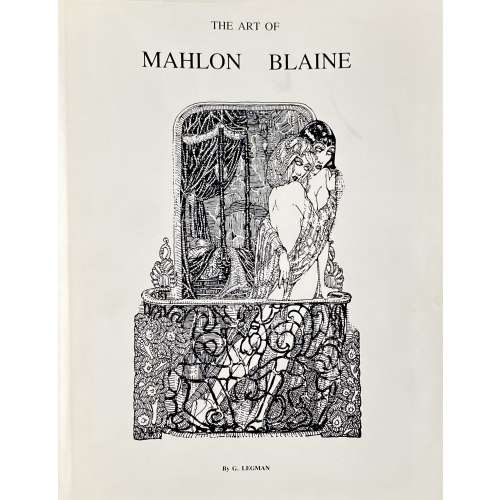 Title page: THE ART OF | MAHLON BLAINE | A Reminiscence | by G. Legman | with a Mahlon Blaine bibliography | compiled by Roland Trenary | {Blaine’s fac-simile} | Peregrine Books | 1982 || Pagination: [1-4] 5-26 + 84 pp. of illustrations, unpaginated. Collation: 13 leaves of text, 40 leaves of b/w plates, and 2 leaves of colour plates, 55 leaves total. Binding: 29 x 22.5 cm; publisher’s black cloth, silver lettering to spine, pictorial endpapers, pictorial dust jacket. Edition: Limited edition of 100 copies (this is №100), signed by Gelman, Trenary, and Arrington. Contributors: Blaine, Mahlon (American, 1894 – 1969) – illustrator. Legman, Gershon (American, 1917 – 1999) – author. Arrington, Robert L. (American, 1984 – 2015) – author, introduction. Trenary, Roland (American) – author, compiler. Peregrine Books (East Lansing, MI) – publisher.
Title page: THE ART OF | MAHLON BLAINE | A Reminiscence | by G. Legman | with a Mahlon Blaine bibliography | compiled by Roland Trenary | {Blaine’s fac-simile} | Peregrine Books | 1982 || Pagination: [1-4] 5-26 + 84 pp. of illustrations, unpaginated. Collation: 13 leaves of text, 40 leaves of b/w plates, and 2 leaves of colour plates, 55 leaves total. Binding: 29 x 22.5 cm; publisher’s black cloth, silver lettering to spine, pictorial endpapers, pictorial dust jacket. Edition: Limited edition of 100 copies (this is №100), signed by Gelman, Trenary, and Arrington. Contributors: Blaine, Mahlon (American, 1894 – 1969) – illustrator. Legman, Gershon (American, 1917 – 1999) – author. Arrington, Robert L. (American, 1984 – 2015) – author, introduction. Trenary, Roland (American) – author, compiler. Peregrine Books (East Lansing, MI) – publisher. -
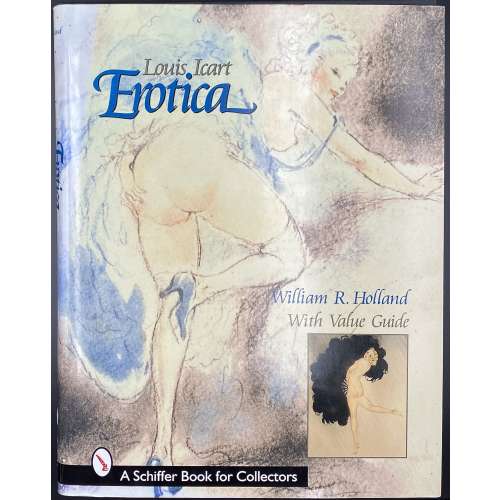 Pictorial title page in blue and black: Louis Icart | Erotica | William R. Holland | {vignette} | Schiffer | Publishing Ltd | 4880 Lower Valley Road, Atglen, PA 19310 USA || Pagination: [1-6] 7-175 [176], plates within pagination. Binding: black cloth, blue lettering to front cover and spine, marbled endpapers, pictorial dust jacket: Louis Icart | Erotica | William R. Holland | With Value Guide | A Schiffer book for collectors || Contributors: Louis Icart (French, 1888 – 1950) – artist. William R. Holland (American, fl. c. 2000) – author. Schiffer Publishing Ltd., – publisher.
Pictorial title page in blue and black: Louis Icart | Erotica | William R. Holland | {vignette} | Schiffer | Publishing Ltd | 4880 Lower Valley Road, Atglen, PA 19310 USA || Pagination: [1-6] 7-175 [176], plates within pagination. Binding: black cloth, blue lettering to front cover and spine, marbled endpapers, pictorial dust jacket: Louis Icart | Erotica | William R. Holland | With Value Guide | A Schiffer book for collectors || Contributors: Louis Icart (French, 1888 – 1950) – artist. William R. Holland (American, fl. c. 2000) – author. Schiffer Publishing Ltd., – publisher. -
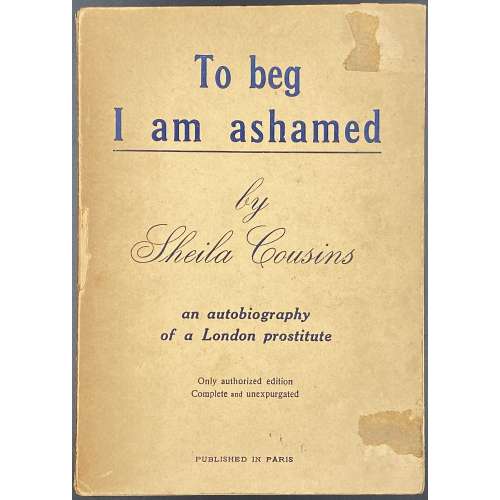 Cover: To beg | I am ashamed | by | Sheila Cousins | An autobiography | of a London prostitute | Only authorized edition | Complete and unexpurgated | PUBLISHED IN PARIS || Title page: SHEILA COUSINS | TO BEG | I AM ASHAMED || Pagination:[4] 1-252], total 256 pages. Binding: Original wrappers, black lettering to front, spine, and back: Price in France and Continent 75 Frs. | Price in America Two Dollars |—| OPERA PRESS || Size: 20.2 x 14.5 cm. Edition: Pirated edition. Contributors: Graham Greene (British, 1904 – 1991) – author. Ronald Matthews (British, 1903 – 1967) – author. Opera Press (Paris) – publisher.
Cover: To beg | I am ashamed | by | Sheila Cousins | An autobiography | of a London prostitute | Only authorized edition | Complete and unexpurgated | PUBLISHED IN PARIS || Title page: SHEILA COUSINS | TO BEG | I AM ASHAMED || Pagination:[4] 1-252], total 256 pages. Binding: Original wrappers, black lettering to front, spine, and back: Price in France and Continent 75 Frs. | Price in America Two Dollars |—| OPERA PRESS || Size: 20.2 x 14.5 cm. Edition: Pirated edition. Contributors: Graham Greene (British, 1904 – 1991) – author. Ronald Matthews (British, 1903 – 1967) – author. Opera Press (Paris) – publisher. -
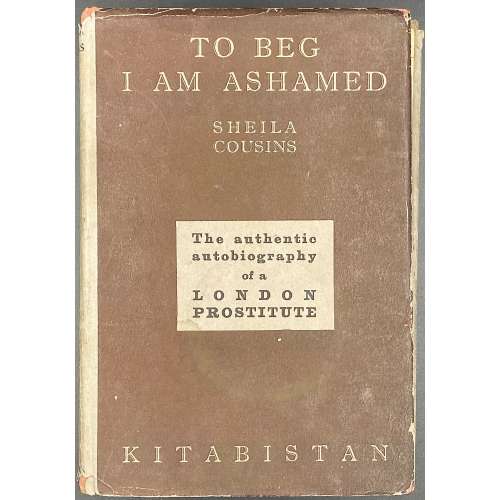 Title page: TO BEG | I AM ASHAMED | By | SHEILA COUSINS | KITABISTAN | ALLAHABAD || Pagination:[1-4] 5-285 [286] [2], total 288 pages. Collation: 8vo; [1]8 2-188; total 144 leaves. Binding: Publisher’s red cloth, black lettering to front cover and spine, price-clipped brown and grey dust jacket, lettered front: TO BEG | I AM ASHAMED | SHEILA | COUSINS |The authentic | autobiography | of a | LONDON | PROSTITUTE | KITABISTAN ||; annotation by Diana Frederics to the back. Size: 19 x 13 cm. Edition: 1st Indian edition. Contributors: Graham Greene (British, 1904 – 1991) – author. Ronald Matthews (British, 1903 – 1967) – author. Frances V. Rummell [pseudonym Diana Fredericks] (American, 1907 – 1969) – annotation author. Kitabistan (Allahabad, India) – publisher. J. K. Sharma at the Allahabad Law Journal Press – printer.
Title page: TO BEG | I AM ASHAMED | By | SHEILA COUSINS | KITABISTAN | ALLAHABAD || Pagination:[1-4] 5-285 [286] [2], total 288 pages. Collation: 8vo; [1]8 2-188; total 144 leaves. Binding: Publisher’s red cloth, black lettering to front cover and spine, price-clipped brown and grey dust jacket, lettered front: TO BEG | I AM ASHAMED | SHEILA | COUSINS |The authentic | autobiography | of a | LONDON | PROSTITUTE | KITABISTAN ||; annotation by Diana Frederics to the back. Size: 19 x 13 cm. Edition: 1st Indian edition. Contributors: Graham Greene (British, 1904 – 1991) – author. Ronald Matthews (British, 1903 – 1967) – author. Frances V. Rummell [pseudonym Diana Fredericks] (American, 1907 – 1969) – annotation author. Kitabistan (Allahabad, India) – publisher. J. K. Sharma at the Allahabad Law Journal Press – printer. -
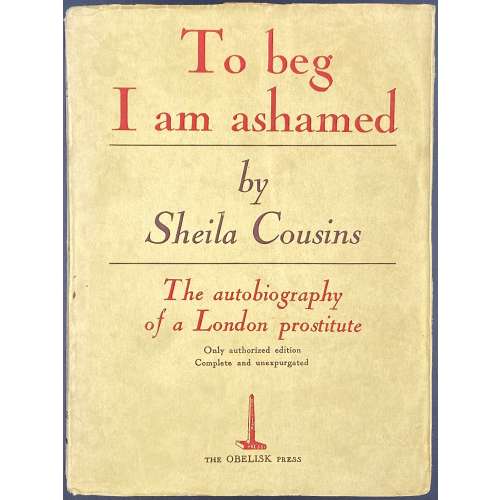 Title page: Sheila Cousins | TO BEG | I AM ASHAMED | {publisher’s device} | THE OBELISK PRESS | 16, PLACE VENDOME | PARIS || Pagination: [2] – blanks (in wrapper), [4] – h.t. / blank, t.p. / publisher's note (to first impression) & copyright, [1] 2-270, [4] uncut (in wrapper) with imprint "Imprimerie Frère Tourcoing", total 280 pages. Collation: 8vo; [A]8 B-Q8 R4 S8; total 140 leaves. Binding: Publisher’s yellow wrappers, lettering to spine:| TO BEG | I AM | ASHAMED |—| SHEILA | COUSINS | 8th | IMPRESSION | {publisher’s device} | THE | OBELISK PRESS | PARIS ||; lettered front wrapper in red and black: To beg | I am ashamed |—| by | Sheila Cousins |—| The autobiography | of a London prostitute | Only authorized edition | Complete and unexpurgated | {publisher’s device} | THE OBELISK PRESS ||, publisher’s device in red to back wrapper; margins untrimmed; in an owner slipcase. Edition: 1st edition, 8th impression, France, (in or after August 1838). Size: 19 x 14.5 cm. Contributors: Graham Greene (British, 1904 – 1991) – author. Ronald Matthews (British, 1903 – 1967) – author. The Obelisk Press (Paris) – publisher. Imprimerie Frère Tourcoing – printer. Compare to the presumably 1st impression of the same edition [LIB-2806.2021].
Title page: Sheila Cousins | TO BEG | I AM ASHAMED | {publisher’s device} | THE OBELISK PRESS | 16, PLACE VENDOME | PARIS || Pagination: [2] – blanks (in wrapper), [4] – h.t. / blank, t.p. / publisher's note (to first impression) & copyright, [1] 2-270, [4] uncut (in wrapper) with imprint "Imprimerie Frère Tourcoing", total 280 pages. Collation: 8vo; [A]8 B-Q8 R4 S8; total 140 leaves. Binding: Publisher’s yellow wrappers, lettering to spine:| TO BEG | I AM | ASHAMED |—| SHEILA | COUSINS | 8th | IMPRESSION | {publisher’s device} | THE | OBELISK PRESS | PARIS ||; lettered front wrapper in red and black: To beg | I am ashamed |—| by | Sheila Cousins |—| The autobiography | of a London prostitute | Only authorized edition | Complete and unexpurgated | {publisher’s device} | THE OBELISK PRESS ||, publisher’s device in red to back wrapper; margins untrimmed; in an owner slipcase. Edition: 1st edition, 8th impression, France, (in or after August 1838). Size: 19 x 14.5 cm. Contributors: Graham Greene (British, 1904 – 1991) – author. Ronald Matthews (British, 1903 – 1967) – author. The Obelisk Press (Paris) – publisher. Imprimerie Frère Tourcoing – printer. Compare to the presumably 1st impression of the same edition [LIB-2806.2021]. -
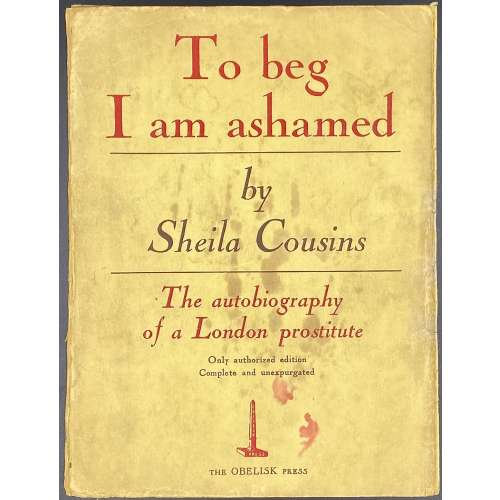 Title page: Sheila Cousins | TO BEG | I AM ASHAMED | {publisher’s device} | THE OBELISK PRESS | 16, PLACE VENDOME | PARIS || Pagination: [2] – blanks (in wrapper), [4] – h.t. / blank, t.p. / publisher's note & copyright, [1] 2-270, [4] uncut (in wrapper), total 280 pages. Collation: 8vo; [A]8 B-Q8 R4 S8; total 140 leaves. Binding: Publisher’s yellow wrappers, lettering to spine:| TO BEG | I AM | ASHAMED |—| SHEILA | COUSINS | {publisher’s device} | THE | OBELISK PRESS | PARIS ||; lettered front wrapper in red and black: To beg | I am ashamed |—| by | Sheila Cousins |—| The autobiography | of a London prostitute | Only authorized edition | Complete and unexpurgated | {publisher’s device} | THE OBELISK PRESS ||, publisher’s device in red to back wrapper; margins untrimmed; in an owner slipcase. Edition: 1st edition, France, May (i.e. June) 1838; presumably the first impression. Size: 19 x 14.5 cm. Contributors: Graham Greene (British, 1904 – 1991) – author. Ronald Matthews (British, 1903 – 1967) – author. The Obelisk Press – publisher.
Title page: Sheila Cousins | TO BEG | I AM ASHAMED | {publisher’s device} | THE OBELISK PRESS | 16, PLACE VENDOME | PARIS || Pagination: [2] – blanks (in wrapper), [4] – h.t. / blank, t.p. / publisher's note & copyright, [1] 2-270, [4] uncut (in wrapper), total 280 pages. Collation: 8vo; [A]8 B-Q8 R4 S8; total 140 leaves. Binding: Publisher’s yellow wrappers, lettering to spine:| TO BEG | I AM | ASHAMED |—| SHEILA | COUSINS | {publisher’s device} | THE | OBELISK PRESS | PARIS ||; lettered front wrapper in red and black: To beg | I am ashamed |—| by | Sheila Cousins |—| The autobiography | of a London prostitute | Only authorized edition | Complete and unexpurgated | {publisher’s device} | THE OBELISK PRESS ||, publisher’s device in red to back wrapper; margins untrimmed; in an owner slipcase. Edition: 1st edition, France, May (i.e. June) 1838; presumably the first impression. Size: 19 x 14.5 cm. Contributors: Graham Greene (British, 1904 – 1991) – author. Ronald Matthews (British, 1903 – 1967) – author. The Obelisk Press – publisher. -
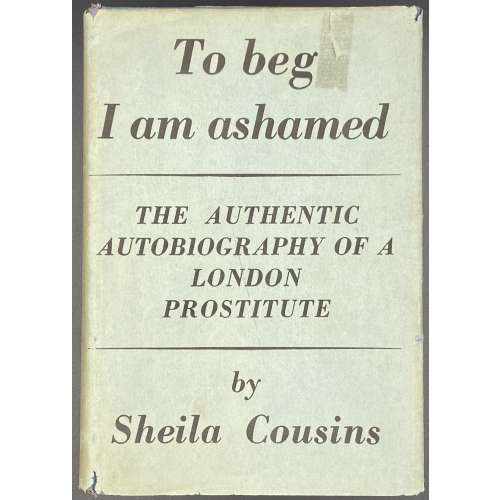 Title page: Sheila Cousins | TO BEG | I AM ASHAMED | THE VANGUARD PRESS • NEW YORK | 1938 || Pagination:[4] [1] 2-283 [284], total 288 pages. Collation: 8vo; [A]8 B-S8; total 144 leaves. Binding: Publisher’s blue buckram, black lettering to front cover and spine, price-clipped blue dust jacket, lettered front: To beg | I am ashamed |—| THE AUTHENTIC | AUTOBIOGRAPHY OF A | LONDON | PROSTITUTE |—| by | Sheila Cousins ||; fore-edge untrimmed. Size: 19.5 x 13.5 cm. Edition: 1st American edition Contributors: Graham Greene (British, 1904 – 1991) – author. Ronald Matthews (British, 1903 – 1967) – author. The Vanguard Press, NY (1926 – 1988) – publisher.
Title page: Sheila Cousins | TO BEG | I AM ASHAMED | THE VANGUARD PRESS • NEW YORK | 1938 || Pagination:[4] [1] 2-283 [284], total 288 pages. Collation: 8vo; [A]8 B-S8; total 144 leaves. Binding: Publisher’s blue buckram, black lettering to front cover and spine, price-clipped blue dust jacket, lettered front: To beg | I am ashamed |—| THE AUTHENTIC | AUTOBIOGRAPHY OF A | LONDON | PROSTITUTE |—| by | Sheila Cousins ||; fore-edge untrimmed. Size: 19.5 x 13.5 cm. Edition: 1st American edition Contributors: Graham Greene (British, 1904 – 1991) – author. Ronald Matthews (British, 1903 – 1967) – author. The Vanguard Press, NY (1926 – 1988) – publisher. -
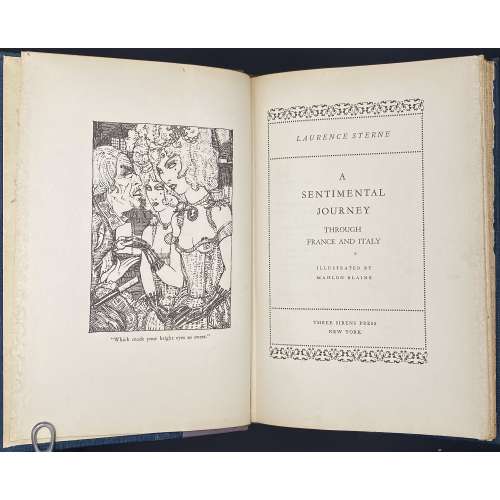 Title page (frame, three compartments: LAURENCE STERNE |—| A | SENTIMENTAL | JOURNEY | THROUGH | FRANCE AND ITALY | ILLUSTRATED BY | MAHLON BLAINE |—| THREE SIRENS PRESS | NEW YORK || Title verso: (top) COPYRIGHT, 1930, BY WILLIAMS, BELASCO & MEYERS | PRINTED IN THE UNITED STATES OF AMERICA | (bottom) BY J. J. LITTLE & IVES COMPANY, NEW YORK || Pagination: [1-6] 7-192, frontispiece, headpiece, and 4 plates within collation (pp. 45, 85, 141, and 185) after Blaine’s pen drawings in the woodcut manner. Binding: quarter lilac morocco with stamped brown lettering over blue cloth, design elements and lettering to spine, top edge gilt, fore-edge untrimmed. Size: 24.5 x 16 cm Edition: presumably 1st edition with plates after Blaine. Contributors: Sterne, Laurence (British-Irish, 1713 – 1768) – author of the text. Blaine, Mahlon (American, 1894 – 1969) – illustrator (pseudonym: G. Christopher Hudson). Three Sirens Press (NY); Williams, Belasco, and Meyers (NY) – publishers. J. J. Little & Ives Company (NY) – printer. Compare to the re-printed edition by Halcyon House, [c. 1950] in the collection [LIB-2783.2021].
Title page (frame, three compartments: LAURENCE STERNE |—| A | SENTIMENTAL | JOURNEY | THROUGH | FRANCE AND ITALY | ILLUSTRATED BY | MAHLON BLAINE |—| THREE SIRENS PRESS | NEW YORK || Title verso: (top) COPYRIGHT, 1930, BY WILLIAMS, BELASCO & MEYERS | PRINTED IN THE UNITED STATES OF AMERICA | (bottom) BY J. J. LITTLE & IVES COMPANY, NEW YORK || Pagination: [1-6] 7-192, frontispiece, headpiece, and 4 plates within collation (pp. 45, 85, 141, and 185) after Blaine’s pen drawings in the woodcut manner. Binding: quarter lilac morocco with stamped brown lettering over blue cloth, design elements and lettering to spine, top edge gilt, fore-edge untrimmed. Size: 24.5 x 16 cm Edition: presumably 1st edition with plates after Blaine. Contributors: Sterne, Laurence (British-Irish, 1713 – 1768) – author of the text. Blaine, Mahlon (American, 1894 – 1969) – illustrator (pseudonym: G. Christopher Hudson). Three Sirens Press (NY); Williams, Belasco, and Meyers (NY) – publishers. J. J. Little & Ives Company (NY) – printer. Compare to the re-printed edition by Halcyon House, [c. 1950] in the collection [LIB-2783.2021].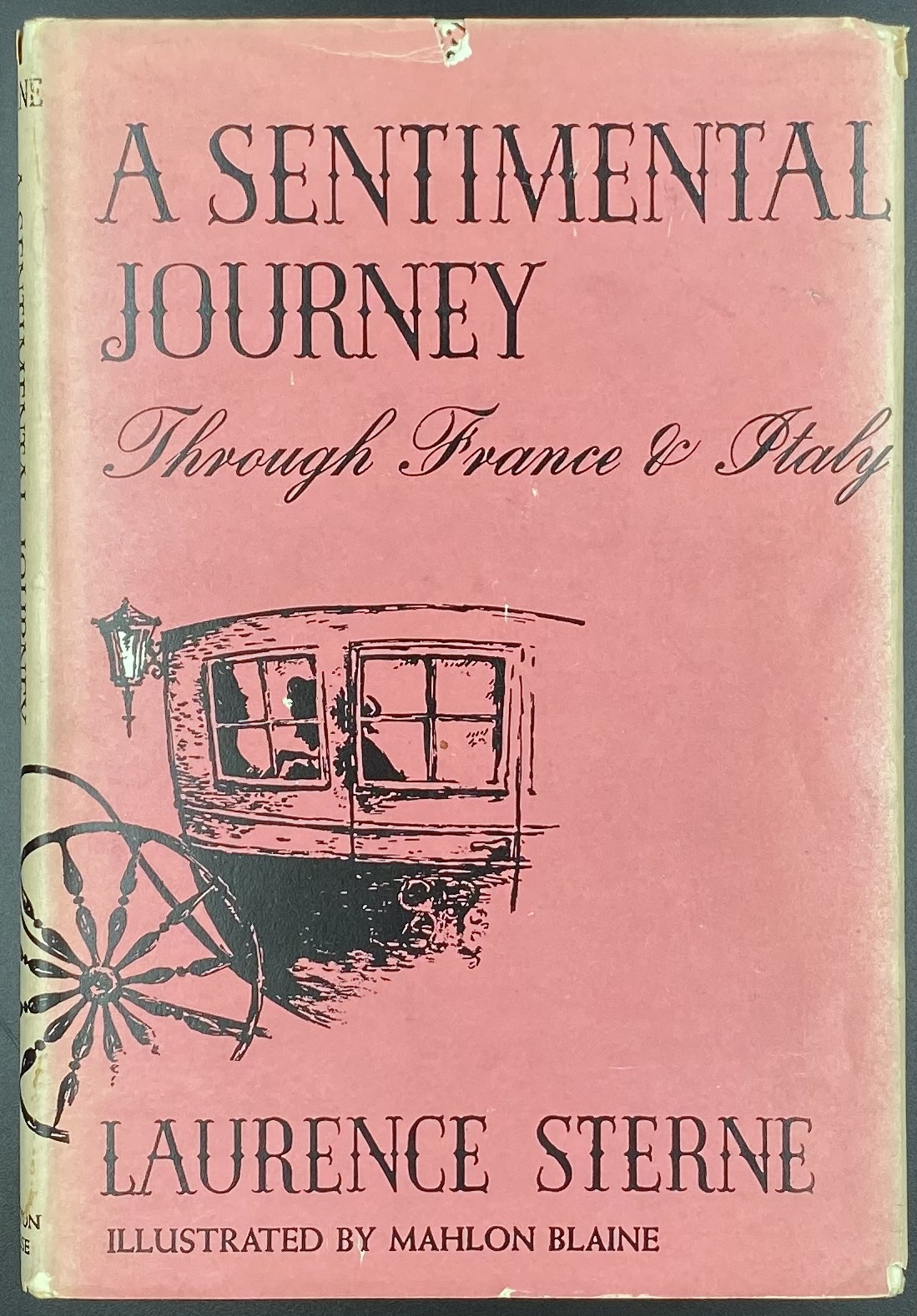 As stated, the copyright is held by Williams, Belasco, and Meyers, who are: Joseph Meyers (c. 1898 – 1957), his sister Edna Williams, and David Belasco (1853 – 1931). "Joseph Meyers was described by Bennet Cerf (Modern Library, Random House) as a “notorious pirate” in Gertzman’s book Bookleggers and Smuthounds, and the trio of presses allegedly indulged in reprinting numerous books without holding the copyright to those titles. By not paying copyright fees, Meyers and Williams were able to print and sell good quality illustrated books at prices that were below typical smaller, unillustrated reprint series of the 1930s." [cit.]
As stated, the copyright is held by Williams, Belasco, and Meyers, who are: Joseph Meyers (c. 1898 – 1957), his sister Edna Williams, and David Belasco (1853 – 1931). "Joseph Meyers was described by Bennet Cerf (Modern Library, Random House) as a “notorious pirate” in Gertzman’s book Bookleggers and Smuthounds, and the trio of presses allegedly indulged in reprinting numerous books without holding the copyright to those titles. By not paying copyright fees, Meyers and Williams were able to print and sell good quality illustrated books at prices that were below typical smaller, unillustrated reprint series of the 1930s." [cit.]
-
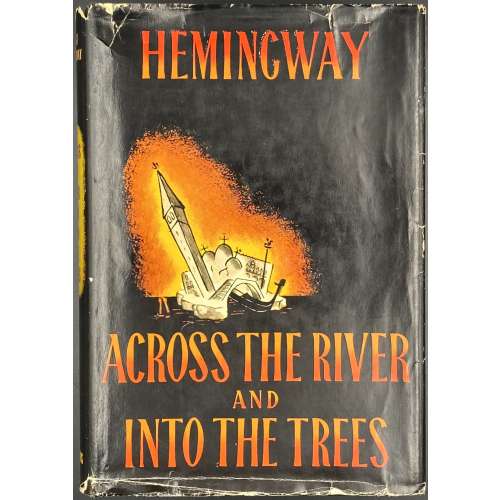 Title page: ACROSS THE RIVER | AND | INTO THE TREES | BY | ERNEST HEMINGWAY | CHARLES SCRIBNER'S SONS | NEW YORK | 1950 || Pagination: [12] 1-308; total 160 leaves. Binding: black cloth, gilt Hemingway's fac-simile to front board, lettering to spine, pictorial dust jacket designed by A. Ivancich; $3.00 price clipped from top of front flap. Bookplate of Feodor Rojankovsky to front pastedown. Size: 21.5 x 15 cm. Edition: 1st edition, 1st printing; DJ with yellow on spine (later copies have orange); letter “A” and the Scribner’s device to copyright page. Provenance: Rojankovsky, Feodor [Rojan; Рожанковский, Фёдор Степанович] (Russian-American, 1891 – 1970) Contributors: Ernest Hemingway (American, 1899 – 1961) – author. Adriana Ivancich (Italian, 1930 – 1983) – artist of the dust jacket (Ivancich inspired the figure of Renata in the novel). Charles Scribner's Sons – publisher.
Title page: ACROSS THE RIVER | AND | INTO THE TREES | BY | ERNEST HEMINGWAY | CHARLES SCRIBNER'S SONS | NEW YORK | 1950 || Pagination: [12] 1-308; total 160 leaves. Binding: black cloth, gilt Hemingway's fac-simile to front board, lettering to spine, pictorial dust jacket designed by A. Ivancich; $3.00 price clipped from top of front flap. Bookplate of Feodor Rojankovsky to front pastedown. Size: 21.5 x 15 cm. Edition: 1st edition, 1st printing; DJ with yellow on spine (later copies have orange); letter “A” and the Scribner’s device to copyright page. Provenance: Rojankovsky, Feodor [Rojan; Рожанковский, Фёдор Степанович] (Russian-American, 1891 – 1970) Contributors: Ernest Hemingway (American, 1899 – 1961) – author. Adriana Ivancich (Italian, 1930 – 1983) – artist of the dust jacket (Ivancich inspired the figure of Renata in the novel). Charles Scribner's Sons – publisher. -
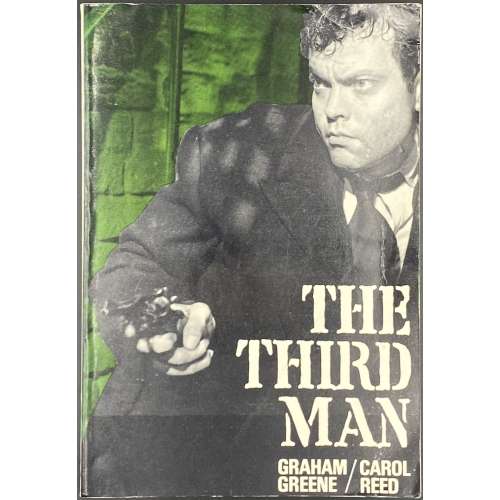 Title page: Title page: MODERN | FILM | SCRIPTS | THE THIRD MAN | a film by | Graham Greene | and Carol Reed | Lorrimer, London. Pagination: [1-4] 5-134 [2] blank; pasted into the last page: The film The Third Man is owned and distributed by British | Lion Films Ltd. Binding: publisher’s pictorial wrappers with the film still and lettering in white to front, and in black to back, and spine. Size: 20.2 x 14 cm. The Third Man is a 1949 British film directed by Carol Reed, written by Graham Greene and starring Joseph Cotten, Alida Valli, Orson Welles, and Trevor Howard. Contributors: Graham Greene (British, 1904 – 1991) – author. Carol Reed (British, 1906 – 1976) – film director. Lorrimer Publishing Limited (London) – publisher. Villiers Publications, Ltd. (London) – printer.
Title page: Title page: MODERN | FILM | SCRIPTS | THE THIRD MAN | a film by | Graham Greene | and Carol Reed | Lorrimer, London. Pagination: [1-4] 5-134 [2] blank; pasted into the last page: The film The Third Man is owned and distributed by British | Lion Films Ltd. Binding: publisher’s pictorial wrappers with the film still and lettering in white to front, and in black to back, and spine. Size: 20.2 x 14 cm. The Third Man is a 1949 British film directed by Carol Reed, written by Graham Greene and starring Joseph Cotten, Alida Valli, Orson Welles, and Trevor Howard. Contributors: Graham Greene (British, 1904 – 1991) – author. Carol Reed (British, 1906 – 1976) – film director. Lorrimer Publishing Limited (London) – publisher. Villiers Publications, Ltd. (London) – printer. -
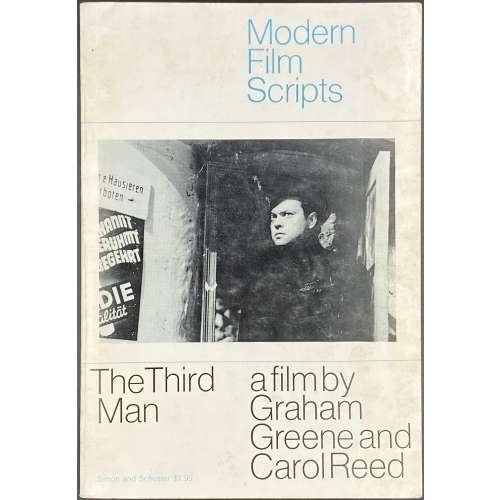 Title page: MODERN | FILM | SCRIPTS | THE THIRD MAN | a film by | Graham Greene | and Carol Reed | Simon and Schuster, New York. Pagination: [1-4] 5-134 [2] blank. Binding: publisher’s pictorial wrappers with the film still and lettering in blue and black to front, back, and spine. Size: 20.2 x 14 cm. The Third Man is a 1949 British film directed by Carol Reed, written by Graham Greene and starring Joseph Cotten, Alida Valli, Orson Welles, and Trevor Howard. Contributors: Graham Greene (British, 1904 – 1991) – author. Carol Reed (British, 1906 – 1976) – film director. Simon & Schuster (NY) – publisher. Villiers Publications, Ltd. (London) – printer.
Title page: MODERN | FILM | SCRIPTS | THE THIRD MAN | a film by | Graham Greene | and Carol Reed | Simon and Schuster, New York. Pagination: [1-4] 5-134 [2] blank. Binding: publisher’s pictorial wrappers with the film still and lettering in blue and black to front, back, and spine. Size: 20.2 x 14 cm. The Third Man is a 1949 British film directed by Carol Reed, written by Graham Greene and starring Joseph Cotten, Alida Valli, Orson Welles, and Trevor Howard. Contributors: Graham Greene (British, 1904 – 1991) – author. Carol Reed (British, 1906 – 1976) – film director. Simon & Schuster (NY) – publisher. Villiers Publications, Ltd. (London) – printer. -
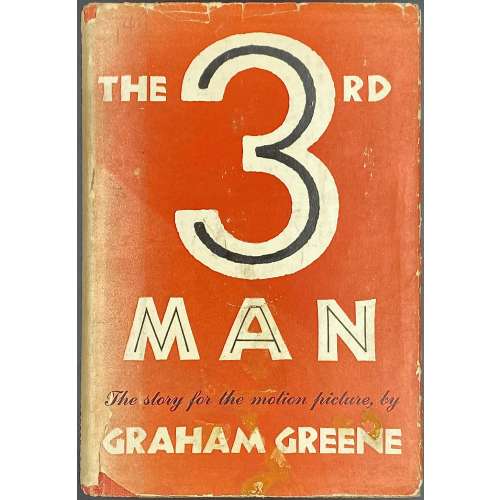 Title page: GRAHAM | GREENE | {vignette} | THE | THIRD MAN | NEW YORK • THE VIKING PRESS • 1950 || Title verso: COPYRIGHT 1949, 1950 BY GRAHAM GREENE | PUBLISHED BY THE VIKING PRESS IN MARCH 1950 | PUBLISHED ON THE SAME DAY IN THE DOMINION OF CANADA | BY THE MACMILLAN COMPANY OF CANADA LIMITED | A condensed version appeared | in The American Magazine, | {publisher’s device} | PRINTED IN U.S.A. BY THE COLONIAL PRESS INC. || Pagination: [1-6] 7-157 [158] [2] blank. Binding: quarter red cloth over grey cloth boards with black lettering to spine, pictorial dust jacket with lettering to front, back and spine, unclipped, $2.00 in the upper-right corner of the front flap. Size:19.5 x 13.5 cm. Edition: 1st American edition. Contributors: Henry Graham Greene (British, 1904 – 1991) – author. The Viking Press, NY (1925 – 1975) – publisher. The Colonial Press, Inc – printer.
Title page: GRAHAM | GREENE | {vignette} | THE | THIRD MAN | NEW YORK • THE VIKING PRESS • 1950 || Title verso: COPYRIGHT 1949, 1950 BY GRAHAM GREENE | PUBLISHED BY THE VIKING PRESS IN MARCH 1950 | PUBLISHED ON THE SAME DAY IN THE DOMINION OF CANADA | BY THE MACMILLAN COMPANY OF CANADA LIMITED | A condensed version appeared | in The American Magazine, | {publisher’s device} | PRINTED IN U.S.A. BY THE COLONIAL PRESS INC. || Pagination: [1-6] 7-157 [158] [2] blank. Binding: quarter red cloth over grey cloth boards with black lettering to spine, pictorial dust jacket with lettering to front, back and spine, unclipped, $2.00 in the upper-right corner of the front flap. Size:19.5 x 13.5 cm. Edition: 1st American edition. Contributors: Henry Graham Greene (British, 1904 – 1991) – author. The Viking Press, NY (1925 – 1975) – publisher. The Colonial Press, Inc – printer. -
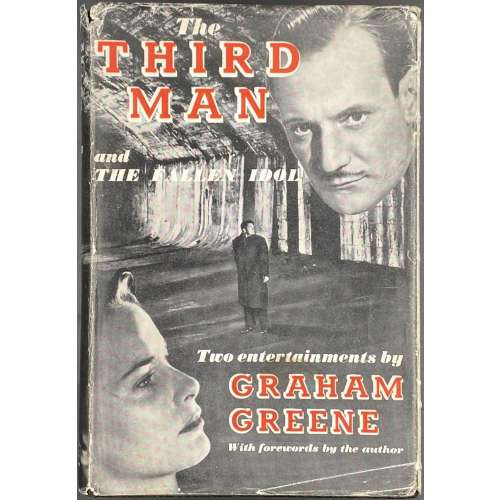 Title page: THE THIRD MAN | and | THE FALLEN IDOL | by | GRAHAM GREENE | {publisher’s device with lettering} |WILLIAM HEINEMANN LTD | MELBOURNE : : LONDON : : TORONTO || Title verso: FIRST PUBLISHED 1950 | PRINTED IN GREAT BRITAIN | AT THE WINDMILL PRESS | KINGSWOOD, SURREY || Pagination:[6] [1, 2] 3-188 [2] blank. Binding: publisher’s black cloth, silver lettering to spine, blind-stamped publisher’s device to back cover in the lower-right corner without lettering; publisher's pictorial dust jacket with lettering (white and read on b/w photo): The | THIRD | MAN | and | THE FALLEN IDOL | The entertainments by | GRAHAM | GREENE | With forewords by the author ||, price clipped. Size: 19 x 13 cm. Edition: 1st edition, 1st printing. Contributors: Graham Greene (British, 1904 – 1991) – author. William Henry Heinemann (British-Jewish, 1863 – 1920); William Heinemann Limited – publisher. The Windmill Press (Kingswood, Surrey) – printer.
Title page: THE THIRD MAN | and | THE FALLEN IDOL | by | GRAHAM GREENE | {publisher’s device with lettering} |WILLIAM HEINEMANN LTD | MELBOURNE : : LONDON : : TORONTO || Title verso: FIRST PUBLISHED 1950 | PRINTED IN GREAT BRITAIN | AT THE WINDMILL PRESS | KINGSWOOD, SURREY || Pagination:[6] [1, 2] 3-188 [2] blank. Binding: publisher’s black cloth, silver lettering to spine, blind-stamped publisher’s device to back cover in the lower-right corner without lettering; publisher's pictorial dust jacket with lettering (white and read on b/w photo): The | THIRD | MAN | and | THE FALLEN IDOL | The entertainments by | GRAHAM | GREENE | With forewords by the author ||, price clipped. Size: 19 x 13 cm. Edition: 1st edition, 1st printing. Contributors: Graham Greene (British, 1904 – 1991) – author. William Henry Heinemann (British-Jewish, 1863 – 1920); William Heinemann Limited – publisher. The Windmill Press (Kingswood, Surrey) – printer. -
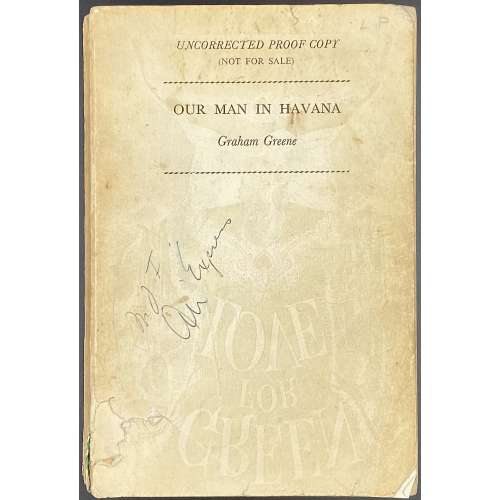 Front cover: UNCORRECTED PROOF COPY | (NOT FOR SALE) | {rule} | OUR MAN IN HAVANA | Graham Greene | {rule} || Half-title: Our Man in Havana ||; stamp on top: LAURENCE POLLINGER LTD. | 18 MADDOX STREET, LONDON, W.1. Title page: {double rule} | Our Man in Havana | AN ENTERTAINMENT | GRAHAM GREENE | {Heinemann’s device} | HEINEMANN | LONDON MELBOURNE TORONTO || Title verso: William Heinemann Ltd | LONDON MELBOURNE TORONTO | CAPE TOWN AUCKLAND | THE HAGUE | First published 1958 | © by Graham Greene 1958 | All rights reserved | Printed in Great Britain | at The Windmill Press | Kingswood, Surrey || Pagination: [6] [1, 2] 3-273 [274]. Binding: 19.5 x 13 cm, cream wrappers with black lettering to front and spine; Cover is verso of the cover for Anne Piper’s Green for Love, a book published by Fletcher & Son in 1954. Edition: Advance copy / Uncorrected proof. Contributors: Henry Graham Greene (British, 1904 – 1991) – author. William Henry Heinemann (British-Jewish, 1863 – 1920); William Heinemann Limited – publisher. Laurence Pollinger Ltd. (London) – literary agent.
Front cover: UNCORRECTED PROOF COPY | (NOT FOR SALE) | {rule} | OUR MAN IN HAVANA | Graham Greene | {rule} || Half-title: Our Man in Havana ||; stamp on top: LAURENCE POLLINGER LTD. | 18 MADDOX STREET, LONDON, W.1. Title page: {double rule} | Our Man in Havana | AN ENTERTAINMENT | GRAHAM GREENE | {Heinemann’s device} | HEINEMANN | LONDON MELBOURNE TORONTO || Title verso: William Heinemann Ltd | LONDON MELBOURNE TORONTO | CAPE TOWN AUCKLAND | THE HAGUE | First published 1958 | © by Graham Greene 1958 | All rights reserved | Printed in Great Britain | at The Windmill Press | Kingswood, Surrey || Pagination: [6] [1, 2] 3-273 [274]. Binding: 19.5 x 13 cm, cream wrappers with black lettering to front and spine; Cover is verso of the cover for Anne Piper’s Green for Love, a book published by Fletcher & Son in 1954. Edition: Advance copy / Uncorrected proof. Contributors: Henry Graham Greene (British, 1904 – 1991) – author. William Henry Heinemann (British-Jewish, 1863 – 1920); William Heinemann Limited – publisher. Laurence Pollinger Ltd. (London) – literary agent. -
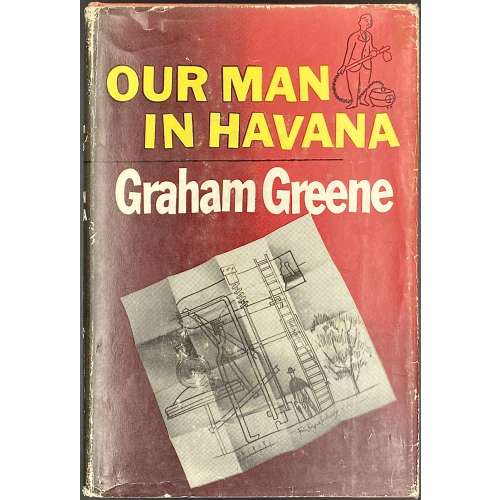 Title page: GRAHAM GREENE | {double rule} | Our Man | in Havana | AN ENTERTAINMENT | {citation: “And the sad man is cock of all his jests.” | — GEORGE HERBERT } | 1958 | THE VIKING PRESS • NEW YORK || Title verso: (top) COPYRIGHT © BY WILLIAM HEINEMANN LIMITED | PUBLISHED IN 1958 BY THE VIKING PRESS, INC. | 625 MADISON AVENUE, NEW YORK 22, N. Y. | (bottom) {publisher’s device} | LIBRARY OF CONGRESS CATALOGUE CARD NUMBER: 58.11735 | PRINTED IN THE U. S. A. BY | AMERICAN BOOK – STRATFORD PRESS || Pagination: [6] [1, 2] 3-273 [274]. Binding: 21 x 14 cm, publisher’s pink cloth, black lettering to spine: {double rule} | GRAHAM GREENE | Our | Man | in | Havana | VIKING | {double rule} ||; black vignette to front cover in the lower-right corner; original pictorial dust jacket designed by Bill English, unclipped, $3.50 in the upper-right corner of the front flap, advertisement “Also by Graham Greene” on the back flap. Edition: 1st American edition. Contributors: Henry Graham Greene (British, 1904 – 1991) – author. Bill English (British, b. 1931) – artist. The Viking Press, NY (1925 – 1975) – publisher. American Book-Stratford Press, Inc. – printer.
Title page: GRAHAM GREENE | {double rule} | Our Man | in Havana | AN ENTERTAINMENT | {citation: “And the sad man is cock of all his jests.” | — GEORGE HERBERT } | 1958 | THE VIKING PRESS • NEW YORK || Title verso: (top) COPYRIGHT © BY WILLIAM HEINEMANN LIMITED | PUBLISHED IN 1958 BY THE VIKING PRESS, INC. | 625 MADISON AVENUE, NEW YORK 22, N. Y. | (bottom) {publisher’s device} | LIBRARY OF CONGRESS CATALOGUE CARD NUMBER: 58.11735 | PRINTED IN THE U. S. A. BY | AMERICAN BOOK – STRATFORD PRESS || Pagination: [6] [1, 2] 3-273 [274]. Binding: 21 x 14 cm, publisher’s pink cloth, black lettering to spine: {double rule} | GRAHAM GREENE | Our | Man | in | Havana | VIKING | {double rule} ||; black vignette to front cover in the lower-right corner; original pictorial dust jacket designed by Bill English, unclipped, $3.50 in the upper-right corner of the front flap, advertisement “Also by Graham Greene” on the back flap. Edition: 1st American edition. Contributors: Henry Graham Greene (British, 1904 – 1991) – author. Bill English (British, b. 1931) – artist. The Viking Press, NY (1925 – 1975) – publisher. American Book-Stratford Press, Inc. – printer. -
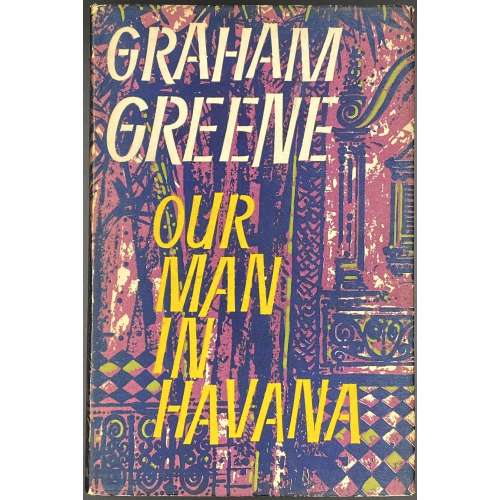 Title page: GRAHAM GREENE | {double rule} | Our Man in Havana | AN ENTERTAINMENT | {publisher’s device: windmill among the hills, letters W and H} | HEINEMANN | LONDON MELBOURNE TORONTO || Title verso: William Heinemann Ltd | LONDON MELBOURNE TORONTO | CAPE TOWN AUCKLAND | THE HAGUE | First published 1958 | © by William Heinemann Limited 1958 | All rights reserved | Printed in Great Britain | at The Windmill Press | Kingswood, Surrey || Pagination: [6] [1, 2] 3-273 [274]. Binding: 20.2 x 13.5 cm, publisher’s blue cloth, gilt lettering to spine (top): OUR | MAN | IN | HAVANA | {double rule} | GRAHAM GREENE | (bottom): HEINEMANN ||; blind-stamped publisher’s device to back cover in the lower-right corner without lettering; pp. 1-122 and 253-274 darker, than the middle pages; original dust jacket designed by Donald Green, unclipped, 15s NET in the lower-right corner of the front flap, advertisement of The quiet American on the back. Edition: 1st edition, 1st printing. Contributors: Graham Greene (British, 1904 – 1991) – author. Donald Green (British, 1919 – 1983) – DJ artist. William Henry Heinemann (British-Jewish, 1863 – 1920); William Heinemann Limited – publisher. The Windmill Press (Kingswood, Surrey) – printer.
Title page: GRAHAM GREENE | {double rule} | Our Man in Havana | AN ENTERTAINMENT | {publisher’s device: windmill among the hills, letters W and H} | HEINEMANN | LONDON MELBOURNE TORONTO || Title verso: William Heinemann Ltd | LONDON MELBOURNE TORONTO | CAPE TOWN AUCKLAND | THE HAGUE | First published 1958 | © by William Heinemann Limited 1958 | All rights reserved | Printed in Great Britain | at The Windmill Press | Kingswood, Surrey || Pagination: [6] [1, 2] 3-273 [274]. Binding: 20.2 x 13.5 cm, publisher’s blue cloth, gilt lettering to spine (top): OUR | MAN | IN | HAVANA | {double rule} | GRAHAM GREENE | (bottom): HEINEMANN ||; blind-stamped publisher’s device to back cover in the lower-right corner without lettering; pp. 1-122 and 253-274 darker, than the middle pages; original dust jacket designed by Donald Green, unclipped, 15s NET in the lower-right corner of the front flap, advertisement of The quiet American on the back. Edition: 1st edition, 1st printing. Contributors: Graham Greene (British, 1904 – 1991) – author. Donald Green (British, 1919 – 1983) – DJ artist. William Henry Heinemann (British-Jewish, 1863 – 1920); William Heinemann Limited – publisher. The Windmill Press (Kingswood, Surrey) – printer. -
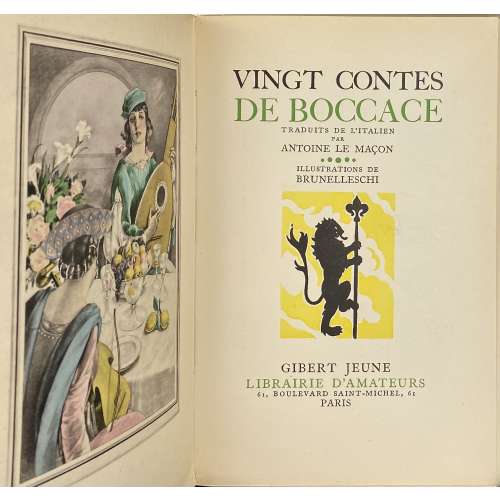 Cover and title, in green and black: VINGT CONTES | DE BOCCACE / TRADUITS DE L’ITALIEN |PAR | ANTOINE LE MAÇON | ILLUSTRATIONS DE | BRUNELLESCHI | {vignette} | GIBERT JEUNE | LIBRAIRIE D’AMATEURS | 61, BOULEVARD SAINT-MICHEL, 61 | PARIS || Pagination : [4] 1-165 [7] with 19 black head- and tailpieces, plus 16 colour plates extraneous to collation, incl. frontispiece, printed by J. Dumoulin and stencil-coloured (au pochoir) by E. Charpentier after gouache and watercolour drawings by Umberto Brunelleschi, plus 2 blank flyleaves; total 106 leaves. Limited edition of 3,000 copies, this is № 1630. Printed by Louis Malexis at Imprimerie J. Dumoulin, Paris (H. Barthélemy, director) on May 28, 1941. Binding: 20.5 x 13.5 cm, publisher’s pictorial wrappers, vignettes and lettering to front wrapper and spine, publisher’s device to back wrapper. Contributors: Giovanni Boccaccio (Italian, 1313 – 1375) – author Antoine Le Maçon (French, c. 1500 – 1559) – translator Umberto Brunelleschi (Italian, 1879 – 1949) – artist Joseph Dumoulin (French, 1875 – 1953) – printer The first, 2-volume limited edition (2,500 copies) of Les Contes de Boccace Decameron (les cinq premières journées, les cinq dernières journées) was published by Gibert Jeune, Librairie d’Amateurs in 1934 with 70 black and 32 colour designs after Brunelleschi – see [LIB-2813.2021]. Description of the stensil (au pochoir) technique.
Cover and title, in green and black: VINGT CONTES | DE BOCCACE / TRADUITS DE L’ITALIEN |PAR | ANTOINE LE MAÇON | ILLUSTRATIONS DE | BRUNELLESCHI | {vignette} | GIBERT JEUNE | LIBRAIRIE D’AMATEURS | 61, BOULEVARD SAINT-MICHEL, 61 | PARIS || Pagination : [4] 1-165 [7] with 19 black head- and tailpieces, plus 16 colour plates extraneous to collation, incl. frontispiece, printed by J. Dumoulin and stencil-coloured (au pochoir) by E. Charpentier after gouache and watercolour drawings by Umberto Brunelleschi, plus 2 blank flyleaves; total 106 leaves. Limited edition of 3,000 copies, this is № 1630. Printed by Louis Malexis at Imprimerie J. Dumoulin, Paris (H. Barthélemy, director) on May 28, 1941. Binding: 20.5 x 13.5 cm, publisher’s pictorial wrappers, vignettes and lettering to front wrapper and spine, publisher’s device to back wrapper. Contributors: Giovanni Boccaccio (Italian, 1313 – 1375) – author Antoine Le Maçon (French, c. 1500 – 1559) – translator Umberto Brunelleschi (Italian, 1879 – 1949) – artist Joseph Dumoulin (French, 1875 – 1953) – printer The first, 2-volume limited edition (2,500 copies) of Les Contes de Boccace Decameron (les cinq premières journées, les cinq dernières journées) was published by Gibert Jeune, Librairie d’Amateurs in 1934 with 70 black and 32 colour designs after Brunelleschi – see [LIB-2813.2021]. Description of the stensil (au pochoir) technique. -
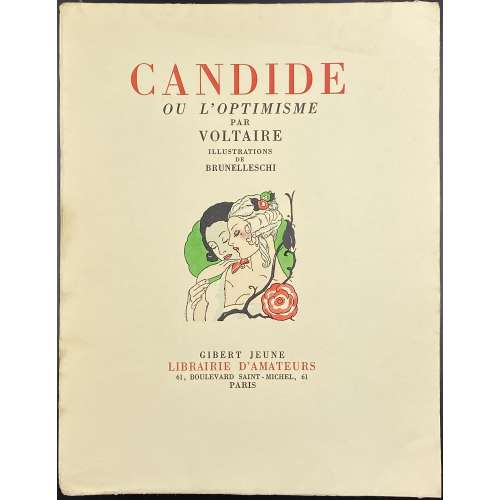 Title (in red and black): CANDIDE | OU L'OPTIMISME | PAR | VOLTAIRE | ILLUSTRATIONS | DE | BRUNELLESCHI | {vignette} | GIBERT JEUNE | LIBRAIRIE D'AMATEURS | 61, BOULEVARD SAINT-MICHEL, 61 | PARIS || Pagination : [6] 1-163 [164][2], with 23 black tailpieces, plus 16 colour plates extraneous to collation, incl. frontispiece, printed by A. Dantan and stencil-coloured (au pochoir) by E. Charpentier after gouache and watercolour drawings by Umberto Brunelleschi; total 102 leaves. Limited edition of 2500 copies, this is № 39. Printed at Imprimerie Coulouma, Argenteuil (H. Barthélemy, director) on July 15, 1933. Binding: 26.5 x 20.5 cm, publisher’s pictorial wrappers, vignettes and lettering to front wrapper and spine, publisher’s device to back wrapper. Description of the stensil (au pochoir) technique.
Title (in red and black): CANDIDE | OU L'OPTIMISME | PAR | VOLTAIRE | ILLUSTRATIONS | DE | BRUNELLESCHI | {vignette} | GIBERT JEUNE | LIBRAIRIE D'AMATEURS | 61, BOULEVARD SAINT-MICHEL, 61 | PARIS || Pagination : [6] 1-163 [164][2], with 23 black tailpieces, plus 16 colour plates extraneous to collation, incl. frontispiece, printed by A. Dantan and stencil-coloured (au pochoir) by E. Charpentier after gouache and watercolour drawings by Umberto Brunelleschi; total 102 leaves. Limited edition of 2500 copies, this is № 39. Printed at Imprimerie Coulouma, Argenteuil (H. Barthélemy, director) on July 15, 1933. Binding: 26.5 x 20.5 cm, publisher’s pictorial wrappers, vignettes and lettering to front wrapper and spine, publisher’s device to back wrapper. Description of the stensil (au pochoir) technique.


